ICOM orporated IC-M1V VHF-FM Marine Hand Held Transceiver User Manual IC M1V
ICOM Incorporated VHF-FM Marine Hand Held Transceiver IC M1V
Contents
- 1. Manual
- 2. Revised page for manual
Manual
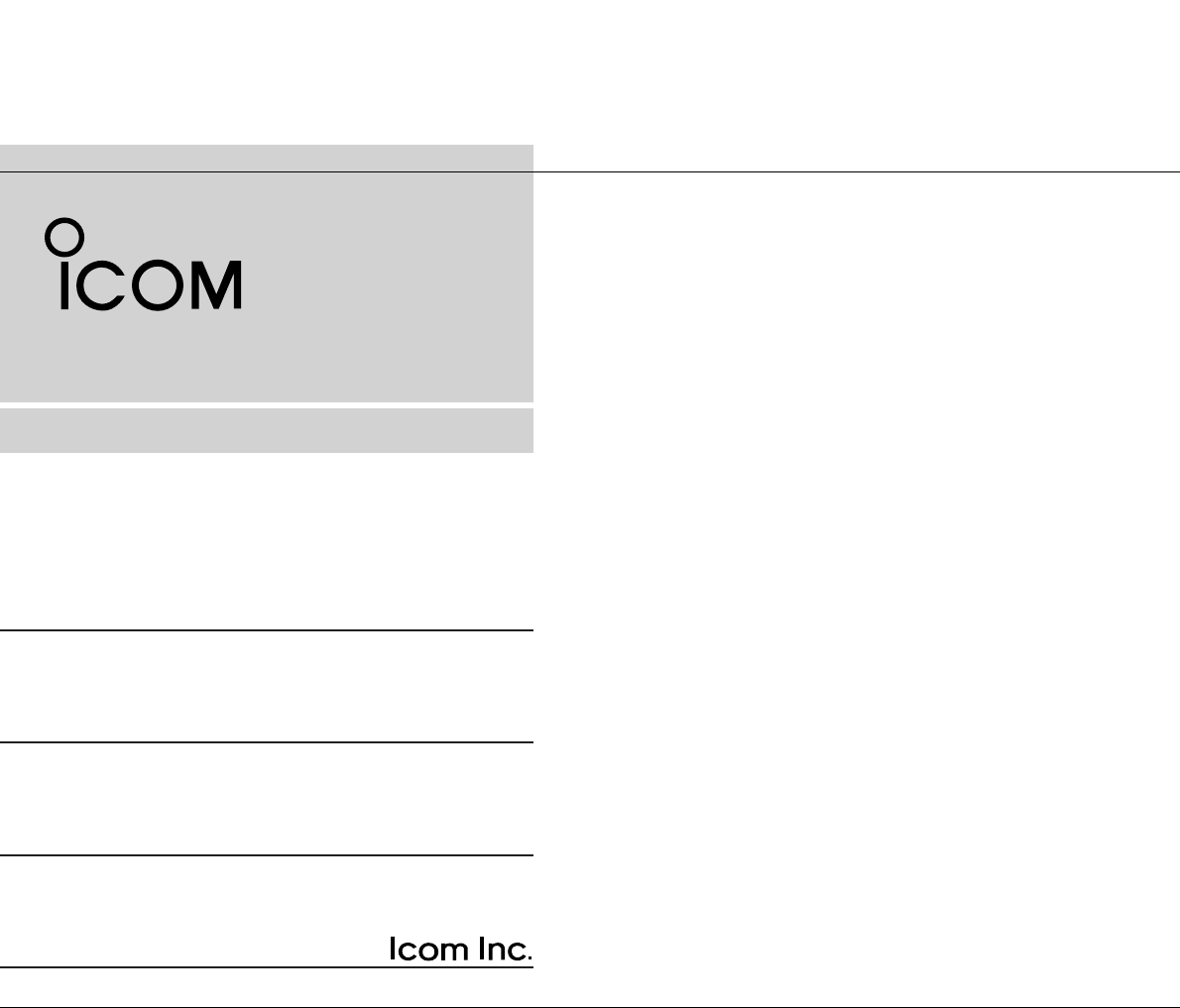
INSTRUCTION MANUAL
This device complies with Part 15 of the FCC rules. Operation is sub-
ject to the following two conditions: (1) This device may not cause
harmful interference, and (2) this device must accept any interference
received, including interference that may cause undesired operation.
iM1V
VHF MARINE TRANSCEIVER
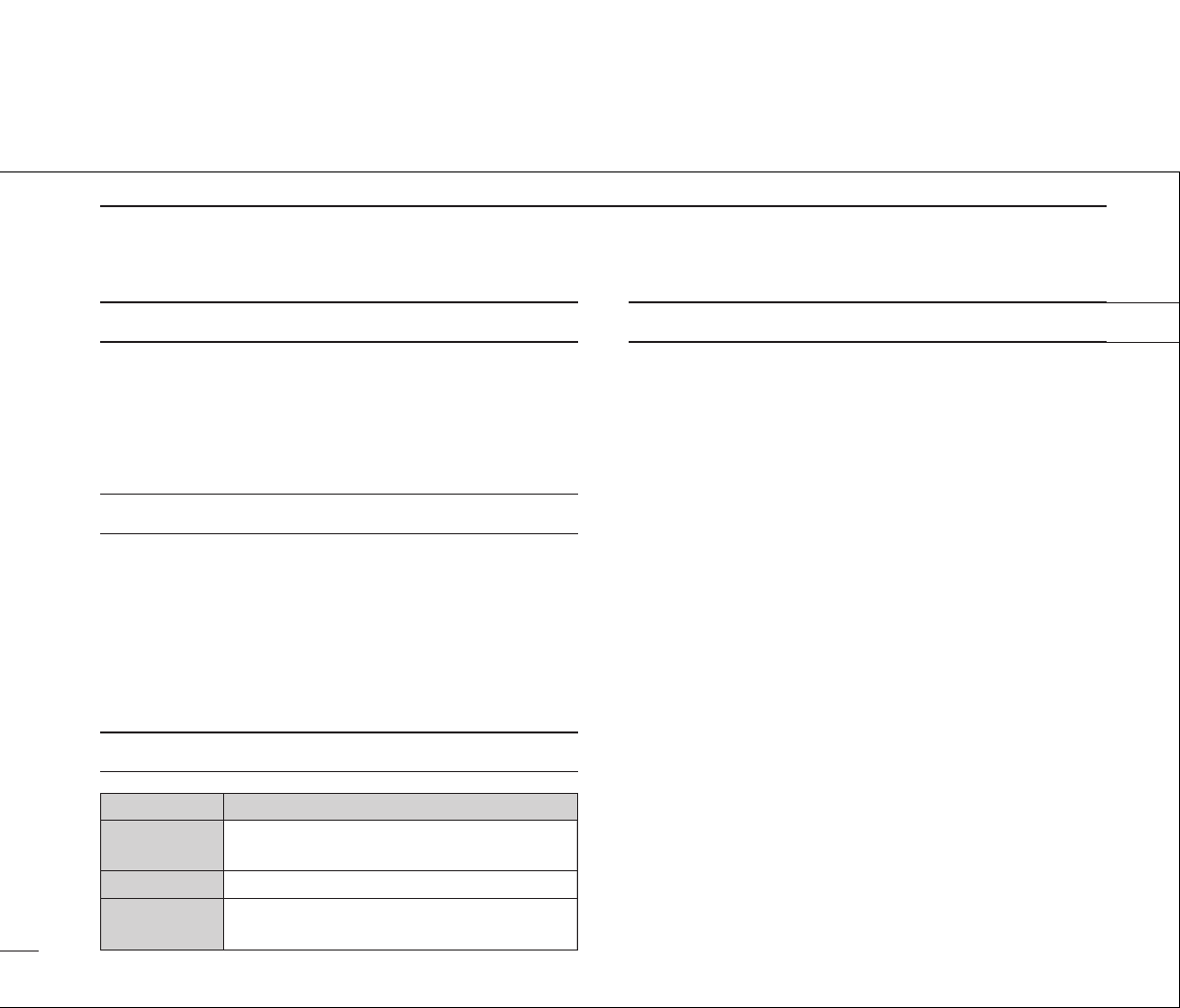
FOREWORD
Thank you for purchasing this Icom product. The IC-M1V
VHF
MARINE TRANSCEIVER
is designed and built with Icom’s superi-
or technology and craftsmanship. With proper care this prod-
uct should provide you with years of trouble-free operation.
IMPORTANT
READ ALL INSTRUCTIONS carefully and completely
before using the transceiver.
SAVE THIS INSTRUCTION MANUAL— This
instruction manual contains important operating instructions
for the IC-M1V.
EXPLICIT DEFINITIONS
CAUTIONS
RWARNING! NEVER connect the transceiver to an AC
outlet. This may pose a fire hazard or result in an electric
shock.
RWARNING! NEVER hold the transceiver so that the
antenna is very close to, or touching exposed parts of the
body, especially the face or eyes, while transmitting. The
transceiver will perform best if the microphone is 5 to 10 cm
(2 to 4 in) away from the lips and the transceiver is vertical.
NEVER connect the transceiver to a power source other
than the BP-215. Such a connection will ruin the transceiver.
NEVER charge battery packs except in the methods
described in this manual.
AVOID using or placing the transceiver in areas with tem-
peratures below –20°C (–4°F) or above +60°C (+140°F).
AVOID the use of chemical agents such as benzine or alco-
hol when cleaning, as they may damage the transceiver sur-
faces. After exposure to saltwater, clean the transceiver thor-
oughly with fresh water to avoid corrosion.
BE CAREFUL! The transceiver rear panel will become
hot when operating continuously for long periods.
i
WORD DEFINITION
RWARNING!
CAUTION
NOTE
Personal injury, fire hazard or electric shock
may occur.
Equipment damage may occur.
It desired, inconvenience only. No risk of
personal injury, fire or electric shock.

BE CAREFUL! The IC-M1V employs waterproof con-
struction, which corresponds to JIS waterproof specification,
grade 7 (1 m/30 min.). However, once the transceiver has
been dropped, it is not guaranteed due to the transceiver may
be cracked, or waterproof seal damaged, etc.
MAKE SURE the flexible antenna and battery pack are
securely attached to the transceiver and that the antenna and
battery pack are dry before attachment. Exposing the inside
of the transceiver to water will result in serious damage to the
transceiver.
KEEP the transceiver at least 1 m (3.3 ft) away from the
ship’s navigation compass.
KEEP the transceiver out of the reach of children.
For U.S.A. only
CAUTION: Changes or modifications to this device, not ex-
pressly approved by Icom Inc., could void your authority to
operate this device under FCC regulations.
IN CASE OF EMERGENCY
If your vessel requires assistance, contact other vessels and
the Coast Guard by sending a distress call on channel 16;
ii
❍
USING CHANNEL 16
DISTRESS CALL PROCEDURE
1. “MAYDAY MAYDAY MAYDAY.”
2. “THIS IS ....................” (name of vessel)
3. Your call sign or other indication of the
vessel.
4. “LOCATED AT ..........” (your position)
5. The nature of the distress and assis-
tance required.
6. Any other information which might facil-
itate the rescue.

iii
TABLE OF CONTENTS
FOREWORD ....................................................................... i
IMPORTANT ........................................................................ i
EXPLICIT DEFINITIONS ..................................................... i
CAUTIONS ...................................................................... i, ii
IN CASE OF EMERGENCY ............................................... ii
TABLE OF CONTENTS .................................................... iii
1 OPERATING RULES........................................................ 1
2 PANEL DESCRIPTION ............................................... 2–5
■ Front panel .................................................................. 2
■ Function display .......................................................... 4
3 BASIC OPERATION .................................................... 4–9
■ Channel selection ........................................................ 5
■ Lock function ............................................................... 6
■ Adjusting the squelch level .......................................... 6
■ Receiving and transmitting .......................................... 7
■ Optional voice scrambler operation ............................. 8
■ Call channel programming .......................................... 9
■ Automatic backlighting ................................................ 9
4 DUALWATCH/TRI-WATCH ........................................... 10
■ Description ................................................................ 10
■ Operation .................................................................. 10
5 SCAN OPERATION ................................................. 11–12
■ Scan types ................................................................. 11
■ Setting tag channels .................................................. 12
■ Starting a scan .......................................................... 12
6 SET MODE .............................................................. 13–14
■ SET mode programming ........................................... 13
■ SET mode items ........................................................ 13
7 BATTERY CHARGING ............................................ 15–16
■ Battery cautions ........................................................ 15
■ Battery charging ........................................................ 15
8 UNPACKING AND ACCESSORY ATTACHMENT ........ 17
9 TROUBLESHOOTING .................................................. 18
10 CHANNEL LIST ........................................................... 19
11 SPECIFICATIONS AND OPTIONS ............................. 20
■ Specifications ............................................................ 20
■ Options ...................................................................... 20
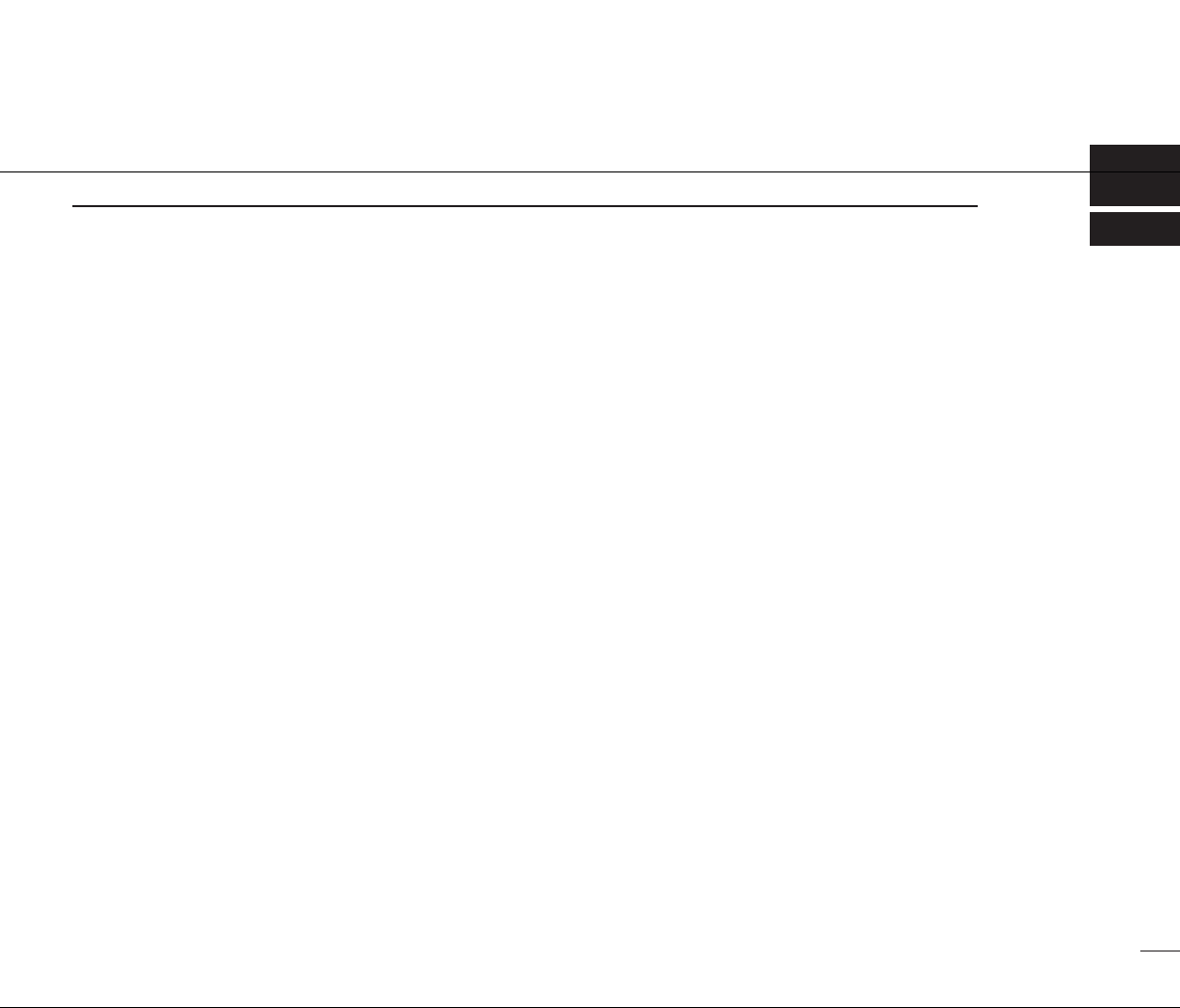
1
1
OPERATING RULES
×PRIORITIES
qRead all rules and regulations pertaining to priorities an
keep an up-to-date copy handy. Safety and distress calls
take priority over all others.
wYou must monitor channel 16 when you are not operating
on another channel.
eFalse or fraudulent distress signals are prohibited and pun-
ishable by law.
×PRIVACY
qInformation overheard but not intended for you cannot law-
fully be used in any way.
wIndecent or profane language is prohibited.
×RADIO LICENSES
(1) SHIP STATION LICENSE
You must have a current radio station license before using the
transceiver. It is unlawful to operate a ship station which is not
licensed.
Inquire through your dealer or the appropriate government
agency for a Ship-Radiotelephone license application. This
government-issued license states the call sign which is your
craft’s identification for radio purposes.
(2) OPERATOR’S LICENSE
A Restricted Radiotelephone Operator Permit is the license
most often held by small vessel radio operators when a radio
is not required for safety purposes.
The Restricted Radiotelephone Operator Permit must be
posted or kept with the operator. Only a licensed radio opera-
tor may operate a transceiver.
However, non-licensed individuals may talk over a transceiver
if a licensed operator starts, supervises, ends the call and
makes the necessary log entries.
Keep a copy of the current government rules and regulations
handy.

■Panel description qANTENNA CONNECTOR
Connects the supplied antenna. (p. 00)
wPTT SWITCH [PTT]
Transmits during push and hold; receives during release.
(p. 00)
eMONITOR SWITCH [MONI]
➥Opens the squelch and monitors the operating channel
while being pushed.
➥While turning power ON, enters the SET mode and pro-
ceeds the SET mode contents when pushed. (p. 00)
rBATTERY PACK RELEASE BUTTON
To remove the battery pack:
Slides the battery release button upwards, then lift up the
battery pack.
To attach the battery pack:
Mate the notched ends of the transceiver and the battery
pack, and click the battery pack into place.
PANEL DESCRIPTION
2
2

tCHANNEL UP/DOWN SWITCHES [Y
Y]/[ZZ]
➥Push either switch to change the operating channel. (p.
00)
➥Push either switch to change the setting during set
mode. (p. 00)
➥Checks tag channels or changes scanning direction dur-
ing scan. (p. 00)
yCHANNEL 16 SWITCH [16•9]
➥Selects channel 16 when pushed. (p. 00)
➥Selects the call channel when pushed for 2 sec. (p. 00)
➥Enters call channel write mode when the call channel is
selected and this switch is pushed for 5 sec. (p. 00)
uVOLUME CONTROL [VOL]
Turns power ON and adjusts the audio level. (p. 00)
iSQUELCH CONTROL [SQL]
Sets the squelch threshold level. (p. 00)
oCHANNEL/WEATHER CHANNEL SWITCH
[CH/WX•U/I/C]
➥Selects and toggles the regular channels and weather
channel when pushed momentarily. (pgs. 00, 00)
➥Selects one of 3 regular channels in sequence when
pushed for 2 sec. (p. 00)
• International, U.S.A. and Canadian channels are avail-
able for regular channels.
!0 DUALWATCH/TRI-WATCH SWITCH [DW•TRI] (p. 00)
➥Starts dualwatch when pushed momentarily.
➥Starts tri-watch when pushed for 2 sec.
➥Stops dualwatch/tri-watch when either is activated.
➥Enters comment writing condition while pushing [MONI].
(p. 00)
!1 SCAN SWITCH [SCAN•TAG]
➥Starts and stops normal or priority scan when tag chan-
nels are programmed. (p. 12)
➥Sets the displayed channel as a tag (scanned) channel
or when pushed for 2 sec. (p. 12)
➥Activates an optional voice scrambler function while
pushing [MONI]. (p. 8)
➥Clears all tag channels in the selected regular channel
when pushed and tuning power ON. (p. 12)
!2 TRANSMIT POWER/LOCK SWITCH [H/L•LOCK]
➥Toggles high and low power (1 W) when pushed. (p. 7)
• Some channels are set to low power only.
➥While pushing [MONI], push this key to select extra low
power (500 mW). (p. 7)
➥Toggles the lock function ON and OFF when pushed for
2 sec. (p. 6)
!3 SPEAKER-MICROPHONE CONNECTOR [SP MIC]
Connects the optional speaker-microphone. (p. 00)
PANEL DESCRIPTION
3
2
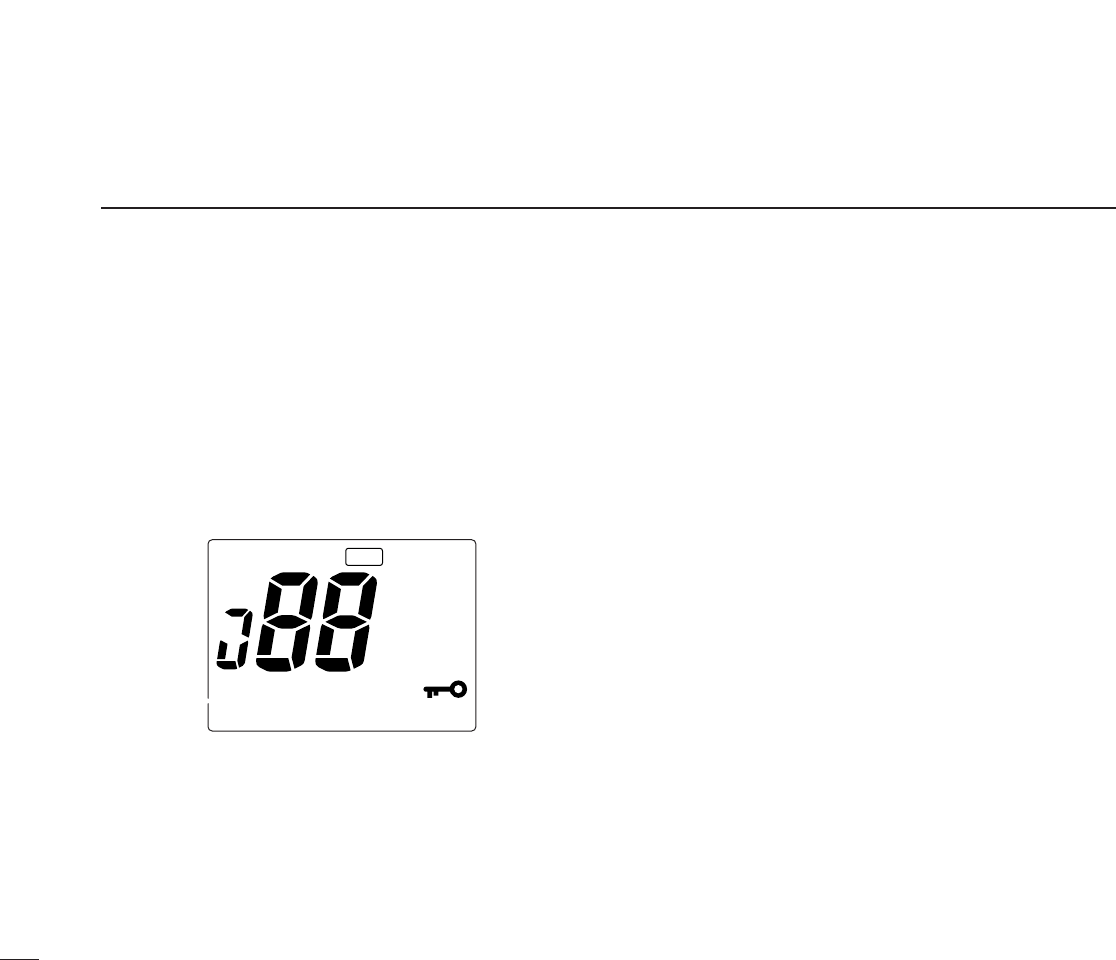
■Function display
qBUSY INDICATOR (p. 00)
Appears while receiving a signal or while the squelch
opens.
wTRANSMIT INDICATOR (p. 00)
Appears while transmitting.
eCHANNEL GROUP INDICATORS (p. 00)
Appears “USA” when U.S.A.; “INT” when international;
“CAN” when Canadian channel group is selected.
rCHANNEL NUMBER READOUT
•Indicates the selected operating channel number. (pgs. 5,
6)
•In SET mode, indicates the selected condition. (pgs. 13,
14)
tATIS INDICATOR
Appears while ATIS function is activated. (Uses German
version only)
yCOMMENT INDICATOR
•Indicates or scrolls operating channel comment. (pgs. 5,
6)
•In SET mode, indicates or scrolls the selected item. (pgs.
13, 14)
PANEL DESCRIPTION
4
2
!1
q
w
e
r
t
yu
i
o
!2
!3
!4
!5
!6
CAN
USA
INT
ATIS
CALL LOW
WX ALT
DUAL
DUP
TRI
TAG
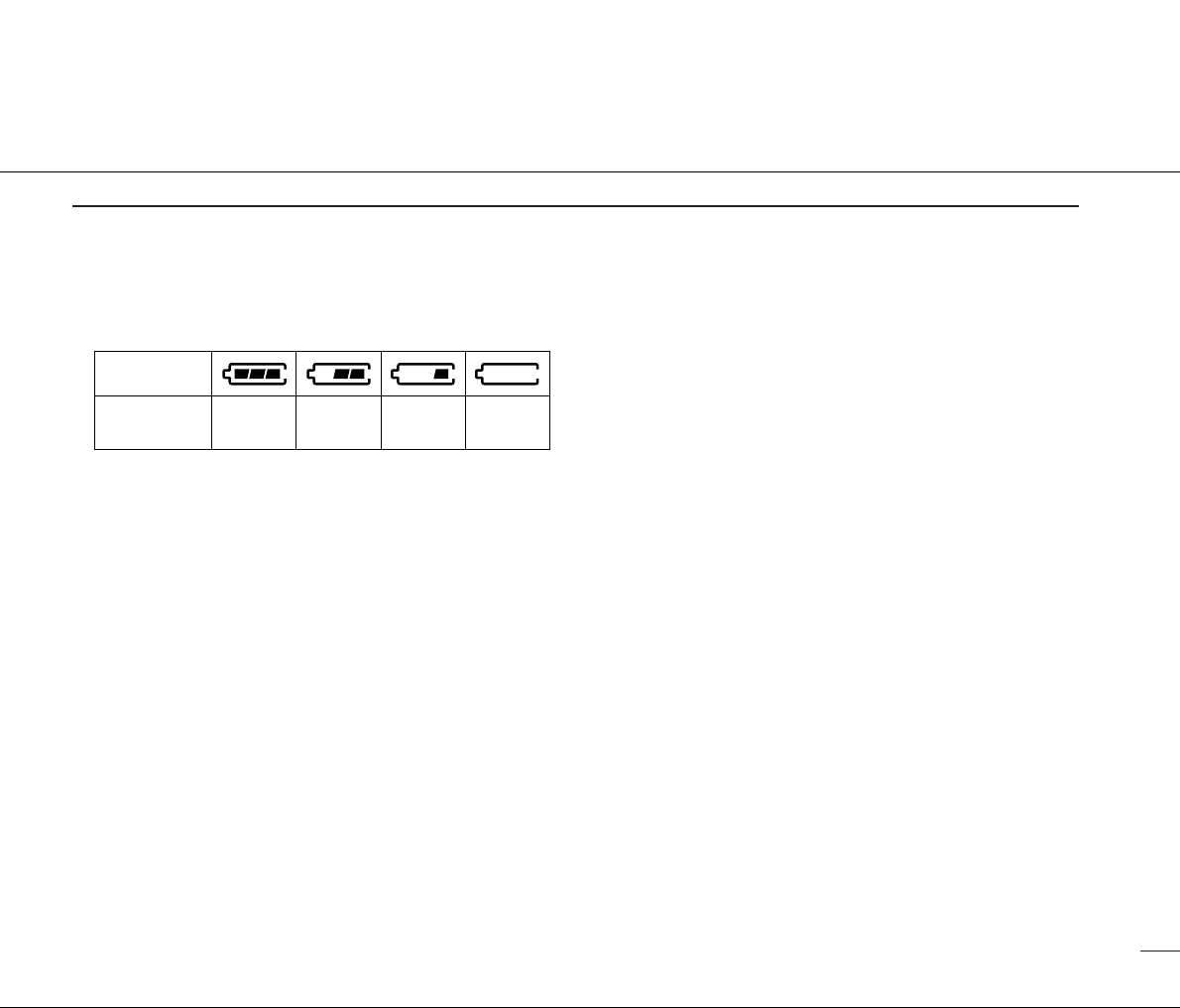
5
2
PANEL DESCRIPTION
uBATTERY INDICATOR
Indicates remaining battery power.
iLOCK INDICATOR (p. 00)
Appears while the lock function is activated.
oSUB CHANNEL READOUT
• Indicates channel 16 during priority scan. (p. 00)
•Indicates channel 16 during dualwatch or tri-watch. (p.
00)
!0 DUPLEX INDICATOR
Appears when a duplex channel is selected.
!1 SCRAMBLER INDICATOR
Appears when the optional voice scrambler is activated.
(p. 00)
!2 DUALWATCH/TRI-WATCH INDICATORS (p. 00)
• “DUAL” blinks during dualwatch.
• “TRI” blinks during tri-watch.
!3 WEATHER CHANNEL/WEATHER ALERT INDICATOR
• “WX” appears when weather channel group is selected.
•“ALT” appears while the weather alert function is acti-
vated; blinks when alert tone is received.
!4 LOW POWER INDICATOR (p. 00)
• Appears when low power is selected.
• Blinks when extra low power is selected.
!5 CALL CHANNEL INDICATOR (p. 00)
Appears when a call channel is selected.
!6 TAG CHANNEL INDICATOR (p. 00)
Appears when a tag channel is selected.
Indication
Battery level Enough Middle Charging
required
Exhausts
soon
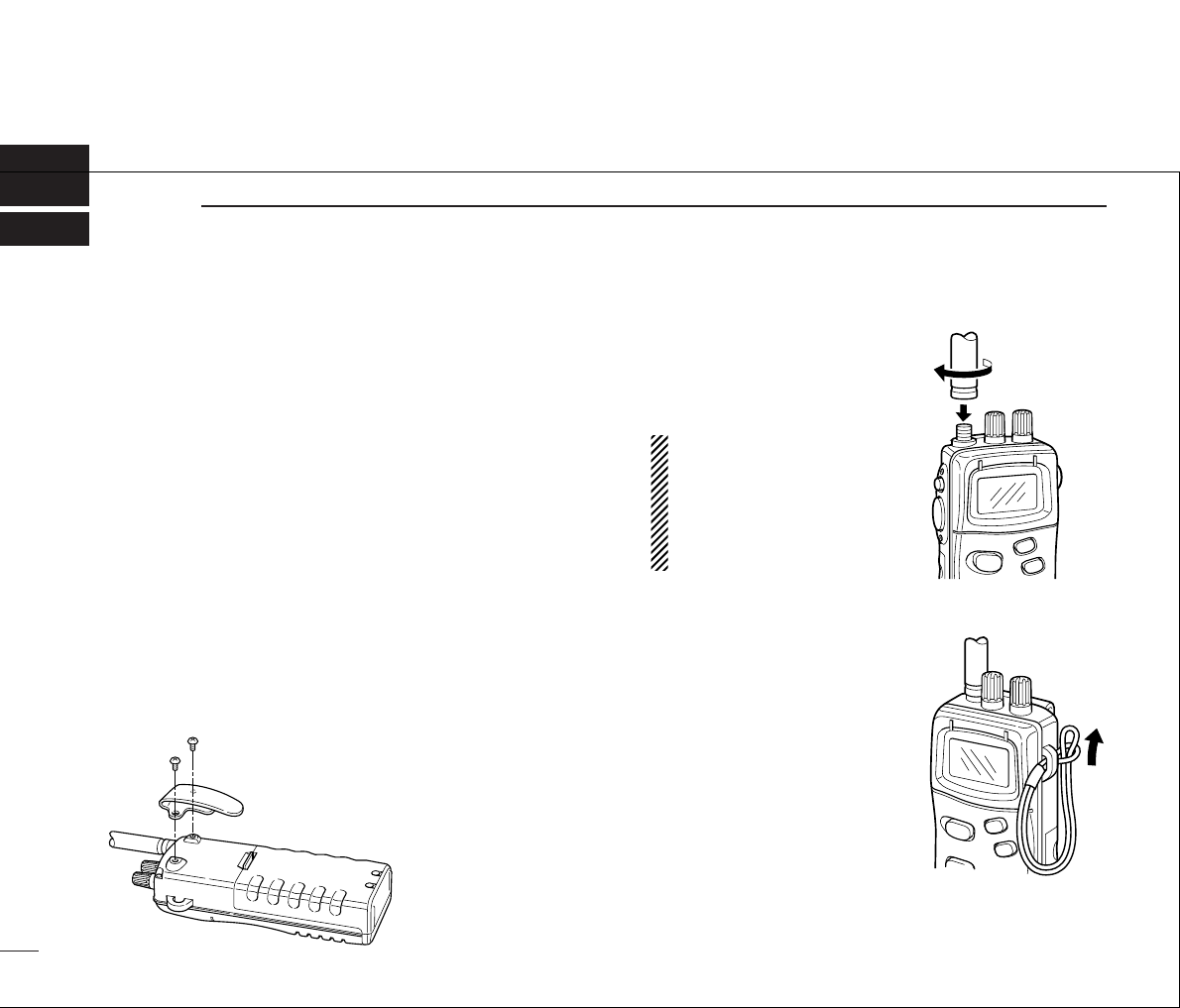
6
3SUPPLIED ACCESSORY AND ATTACHMENT
×Supplied accessories
The following accessories are supplied: Qty.
qFlexible antenna (FA-S57V) .................................1
wBattery pack (BP-215) ..........................................1
eBattery charger (AD-95) .......................................1
rAC adapter* (BC-122A/E/V*) ...............................1
tHandstrap ............................................................1
yBelt clip ................................................................1
uScrews for the belt clip (M3 ×4) ..........................2
iScrews for the AD-95 (M3.5 ×30)........................ 2
*Depending on version
×Belt clip attachment
Attach the belt clip with the supplied screws. Conveniently
attaches to your belt.
×Flexible antenna attachment
Insert the supplied antenna into
the antenna connector and screw
down the antenna as shown in
the diagram at right.
CAUTION: Attach the supplied
antenna securely for water-
proofing.
CAUTION: Transmitting with-
out an antenna may damage
the transceiver.
×Handstrap attachment
Slide the handstrap through the
loop on the side of the transceiver
as illustrated at right.
Facilitates carrying.
NEVER use the supplied screws with-
out the belt clip, otherwise, the screw
holes may be damaged and the trans-
ceiver might not be waterproof. Use the
supplied screws only when attaching
the belt clip.
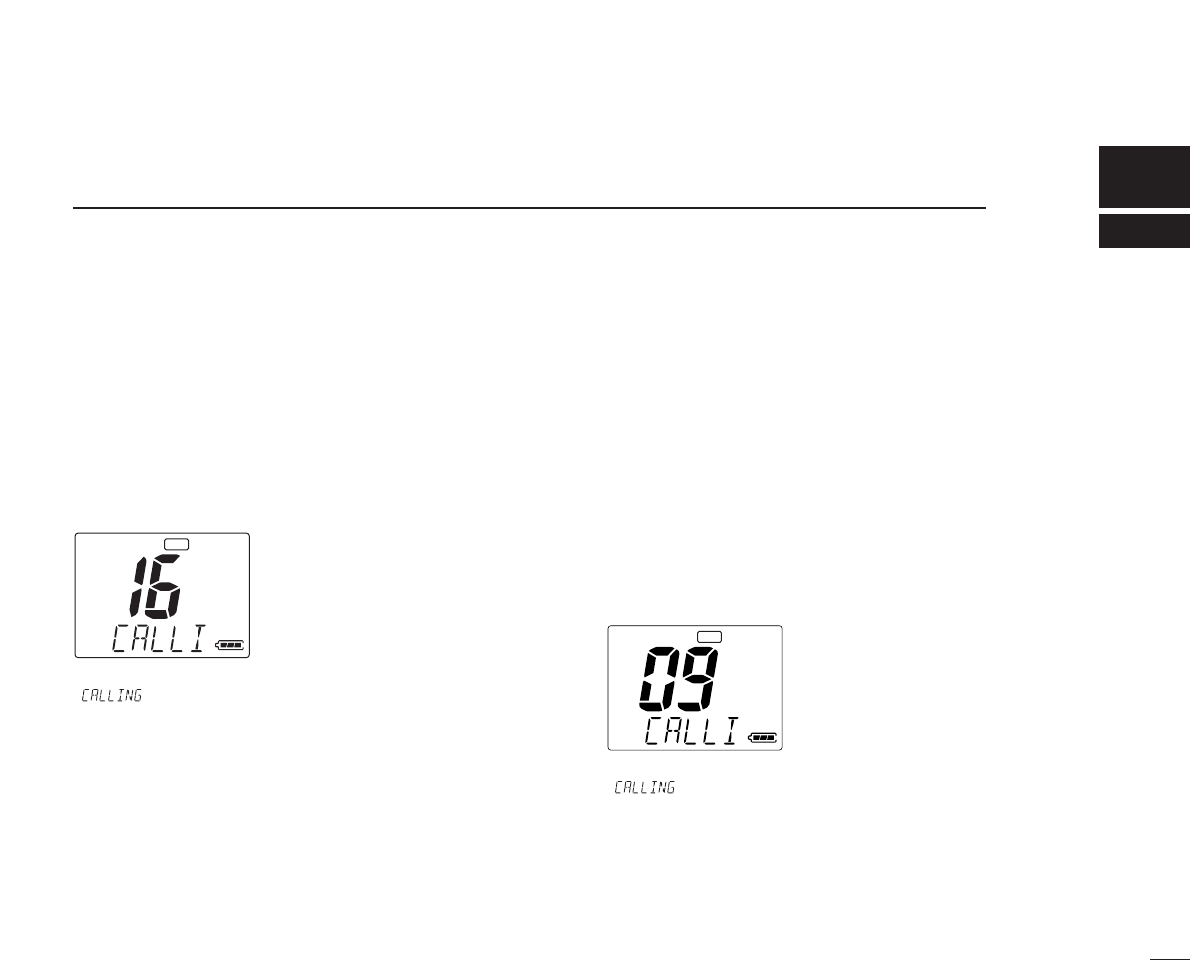
7
4
BASIC OPERATION
■Channel selection
×Channel 16
Channel 16 is the distress channel. It is used for establishing
initial contact with another station and for emergency com-
munications. Channel 16 is automatically monitored during
both dualwatch and tri-watch. While standing-by you have to
monitor channel 16.
Channel 16 is instantly re-called when [16] is pushed.
×Channel 9 (Call channels)
Channel 9 is the pleasure call channel. Each regular channel
group has separate call channels. In addition, each call chan-
nel is monitored during tri-watch. The call channels can be
programmed (p. ??) and are used to store your most often
used channels in each group for quick recall.
➥Push [16¥9] for 2 sec. to select the call channel; of the se-
lected channel group.
• “CALL” indicator and call channel number appear.
• Each channel group may have an independent call channel after
changing a call channel.
USA
CALL
TAG
A channel comment
“ ” is scrolled.
USA
TAG
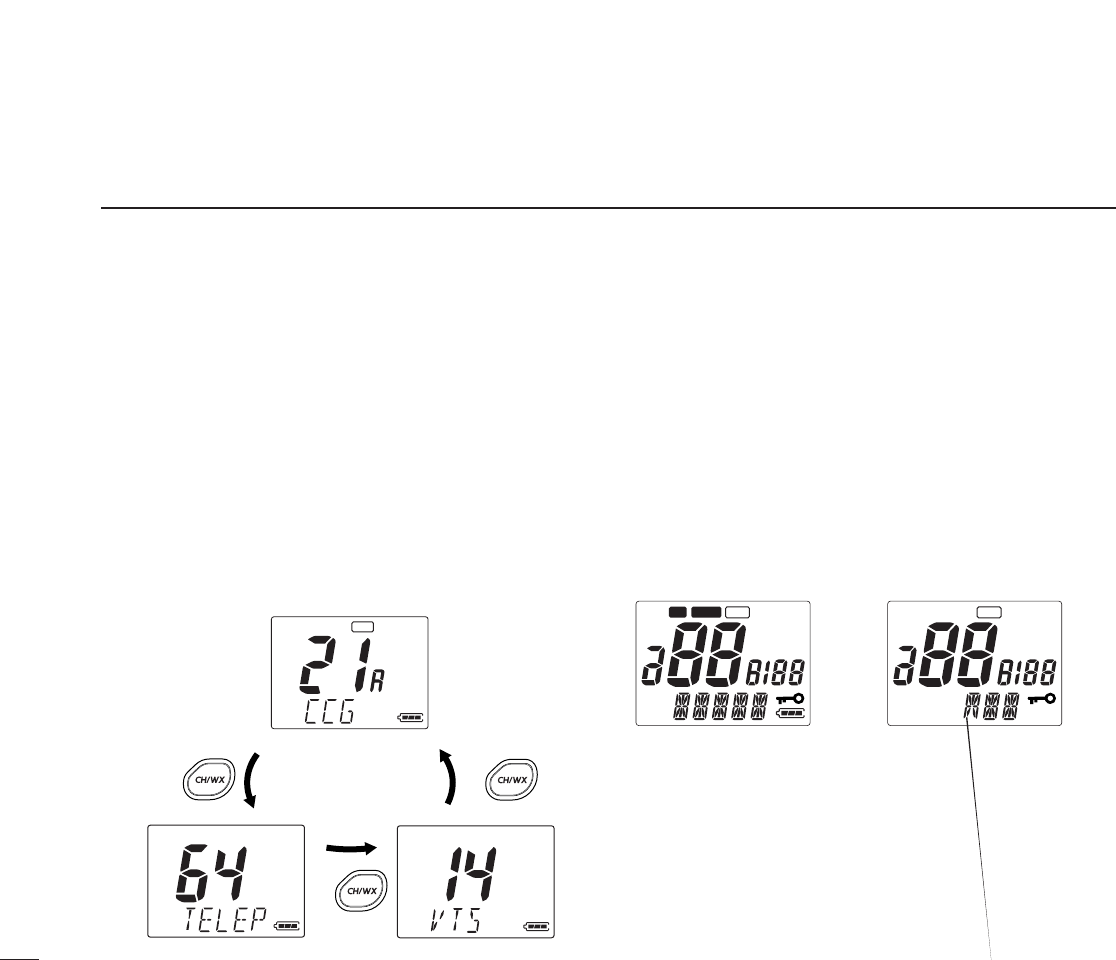
8
4BASIC OPERATION
×U.S.A., Canadian and international channels
There are 57 international, 61 U.S.A. and 57 Canadian chan-
nels. These channel groups may be specified for the operat-
ing area.
qPush [CH/WX] to select a regular channel.
• If a weather channel appears, push [CH/WX] again.
wPush [Y]/[Z] to select a channel.
• “DUP” appears for duplex channels.
eTo change the channel group, push [CH/WX•U/I/C] for
2 sec.
• U.S.A., Canadian and international channels can be selected in
sequence.
×Weather channels
There are 10 weather channels. Used for monitoring weather
channels from the NOAA (National Oceanographic and At-
mospheric Administration) broadcasts.
The IC-M1V can detect a weather alert tone on the selected
weather channel while receiving the channel, during standby
on a regular channel or while scanning. See the “SET mode
items” on p. 14.
➥Push [CH/WX] once or twice to select weather channels.
Push for 1 sec. U.S.A. channels
Canadian channelsInternational channels
U/I/C
U/I/C
U/I/C
CAN
DUP
USA
TAG
INT
CAN
USA
INT
ATIS
CALL LOW
WX ALT
DUAL
DUP
TRI
TAG
TX
BUSY
SCRM
CAN
USA
INT
ATIS
CALL LOW
WX ALT
DUAL
DUP
TRI
TAG

4
BASIC OPERATION
9
■Receiving and transmitting
CAUTION: Transmitting without an antenna may dam-
age the transceiver.
qRotate [VOL] clockwise to turn power ON, then set to the
10 o’clock position.
• Turn [SQL] clockwise to mute any audio noise if necessary. Refer
to the previous page for details.
wPush [Y]/[Z] to select the desired channel.
• When receiving a signal, “BUSY” appears and audio is emitted
from the speaker.
• Further adjustment of [VOL] may be necessary at this point.
• Use the optional voice scrambler function for privacy. (p. 8)
ePush [H/L] to select the output power if necessary.
• “LOW” appears when low power is selected.
•Choose low power to conserve battery power, choose high
power for longer distance communications.
• Some channels are for low power only.
• An extra low power, Low 2, is available for short distance com-
munications. Push [H/L] while pushing [MONI] in such case.
rPush and hold [PTT] to transmit, then speak into the mi-
crophone.
• “TX” appears.
• Channel 70 cannot be used for transmission (for GMDSS use).
tRelease [PTT] to receive.
IMPORTANT: To maximize the readability of your trans-
mitted signal (voice), pause a few sec. after pushing [PTT],
hold the microphone 10 to 15 cm (4 to 6 inches) from your
mouth and speak at a normal voice level.
The transceiver has power save function to conserve the
battery power and cannot be turned OFF. The power save
function activates automatically when no signal is received
for 5 sec.
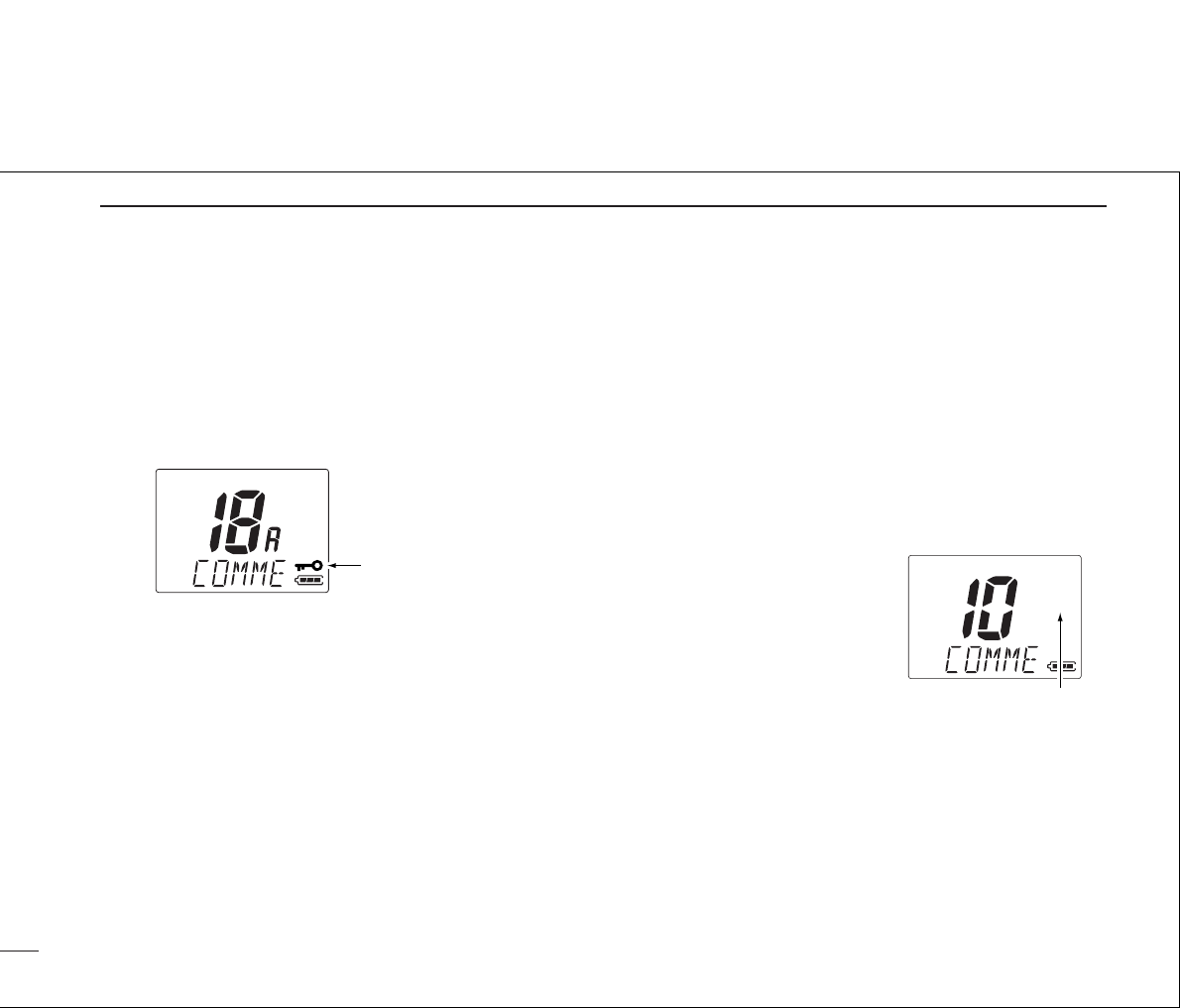
10
4BASIC OPERATION
■Lock function
This function electronically locks all keys and switches to pre-
vent accidental frequency changes and function access.
➥Push [H/L•LOCK] for 2 sec. to turn the lock function ON
and OFF.
• Only [PTT], [H/L] and [MONI] are functional.
■Automatic backlighting
This function is convenient for nighttime operation. The auto-
matic backlighting can be activated in SET mode. (p. 13)
➥Push any key except for [PTT] to turn the backlighting ON.
• The backlighting is automatically turned OFF 5 sec. after opera-
tion.
•Push [MONI] to turn the backlighting ON without changing the
operating condition.
■Optional voice scrambler
operation
×Activating the scrambler
The optional voice scrambler provides private communica-
tions. In order to receive or send scrambled transmissions
you must first activate the scrambler function. To activate the
function, either an optional UT-98 or UT-122 is necessary. Ask
your dealer for details.
qSelect an operating channel
except channel 16 or weather
channels.
wPush [SCN] while pushing and
holding [MONI].
• “SCRM” appears.
eTo turn the scrambler function
OFF, repeat step w.
• “SCRM” disappears.
×Programming scramble codes
There are 128 codes (00 to 127) available with UT-98 or 32
codes (00 to 31) available with UT-122 for programming. In
order to understand one another, all transceivers in your
group must have the same scramble code, as well as the
same unit. See page ?? for scrambling code setting for de-
tails
USA
SCRM
Appears when the voice
scrambler function is in use.
Appears when the
lock function is in use.
USA
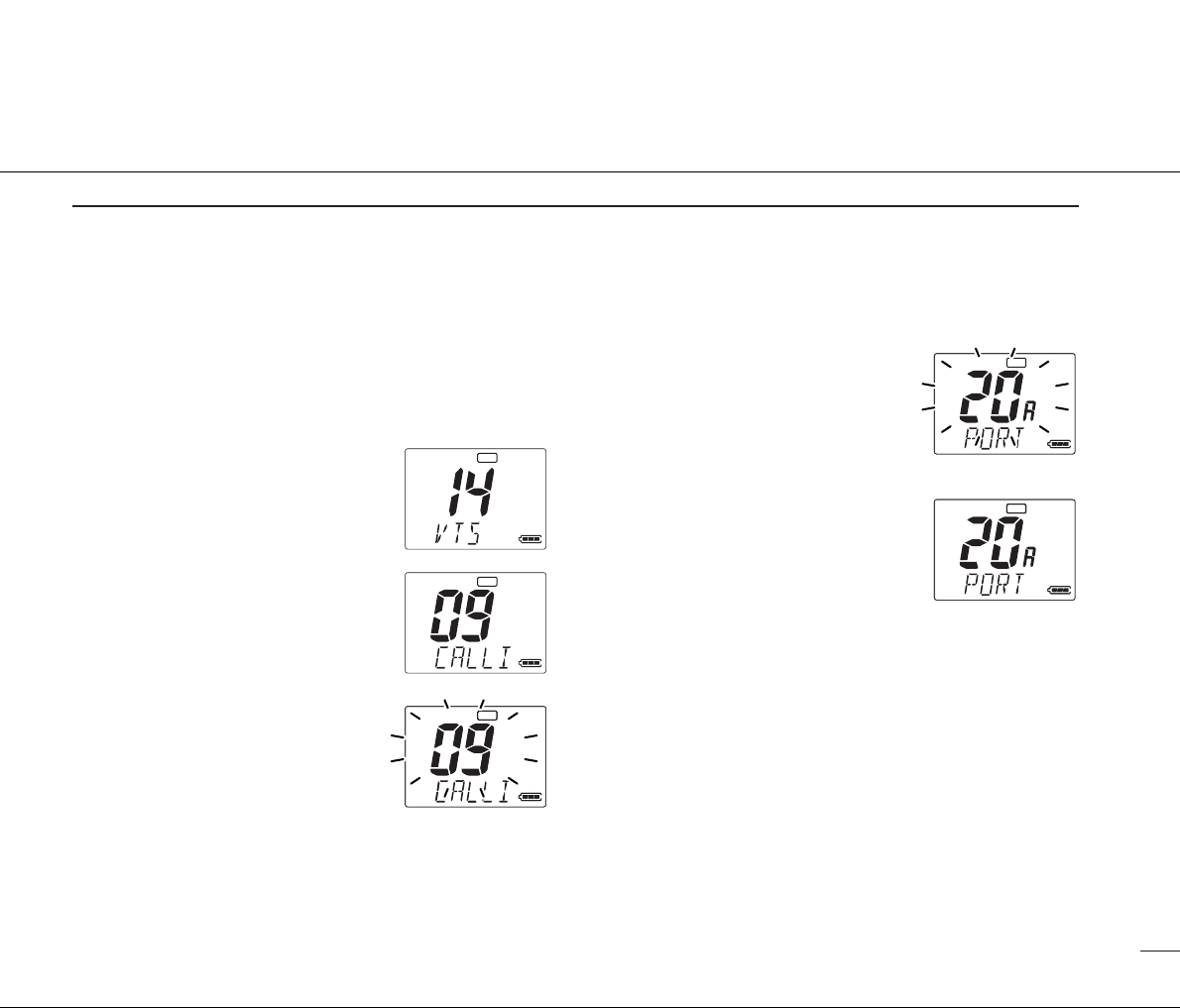
11
4
BASIC OPERATION
■Call channel programming
The call channel key is used to select channel 9, however,
you can program your most often-used channels in each
channel group for quick recall.
qPush [CH/WX•U/I/C] for 2 sec. sev-
eral times to select the desired
channel group (USA, INT, CAN) to
be programmed.
wPush [16•9] for 2 sec. to select the
call channel of the selected chan-
nel group.
•“CALL” and call channel number ap-
pear.
ePush [16•9] again for 5 sec. (until
long beep changes to 2 short
beeps) to enter call channel pro-
gramming condition.
•Call channel number and channel
group to be programmed flashes.
rPush [Y]/[Z] to select the desired
channel.
tPush [16•9] to program the dis-
played channel as the call channel.
• The call channel number and channel
group stop flashing.
USA
TAG
USA
TAG
USA
CALL
TAG
USA
CALL
TAG
USA
TAG CALL
USA
TAG
USA
CALL
TAG
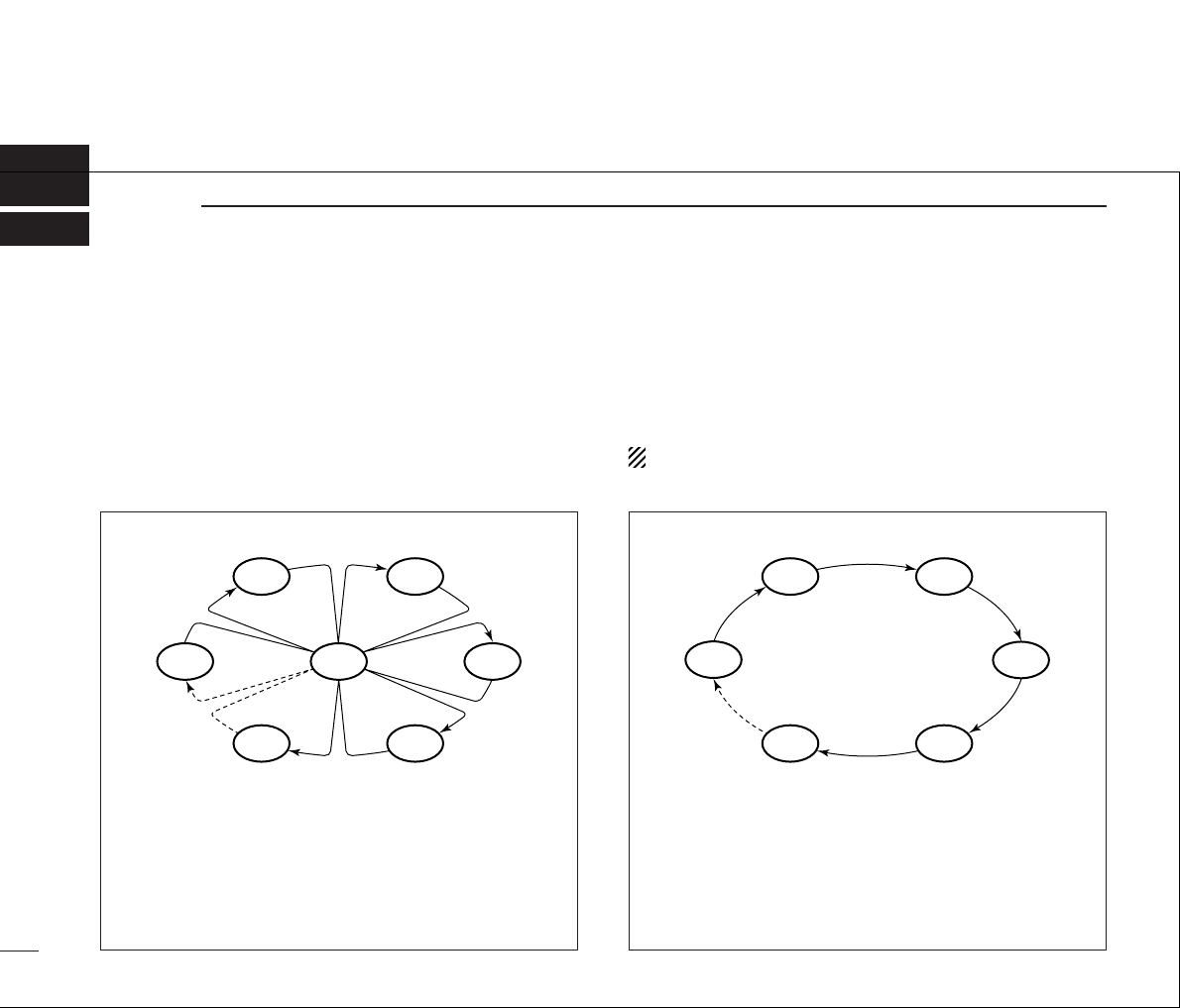
■Scan types
Scanning is an efficient way to locate signals quickly over a
wide frequency range. The transceiver has priority scan and
normal scan.
In addition, weather alert and automatic scan start function is
available for standby convenience. (p. 14)
Set the tag channels (scanned channel) before scanning.
Clear the tag channels which inconveniently stop scanning,
such as digital communication use.
Choose priority or normal scan in SET mode. (p. 14)
NORMAL SCAN
Normal scan, like priority scan, searches through all tag
channels in sequence. However, unlike priority scan, chan-
nel 16 is not checked unless channel 16 is set as a tag
channel.
CH 01 CH 02
WX*
CH 05 CH 04
CH 03
5SCAN OPERATIONS
12
*Previously selected weather channel when
weather alert function is ON.
PRIORITY SCAN
Priority scan searches through all tag channels in se-
quence while monitoring channel 16. When a signal is de-
tected on channel 16, scan pauses until the signal disap-
pears; when a signal is detected on a channel other than
channel 16, scan becomes dualwatch until the signal dis-
appears.
WX*
CH 01
CH 16
CH 02
CH 05 CH 04
CH 03
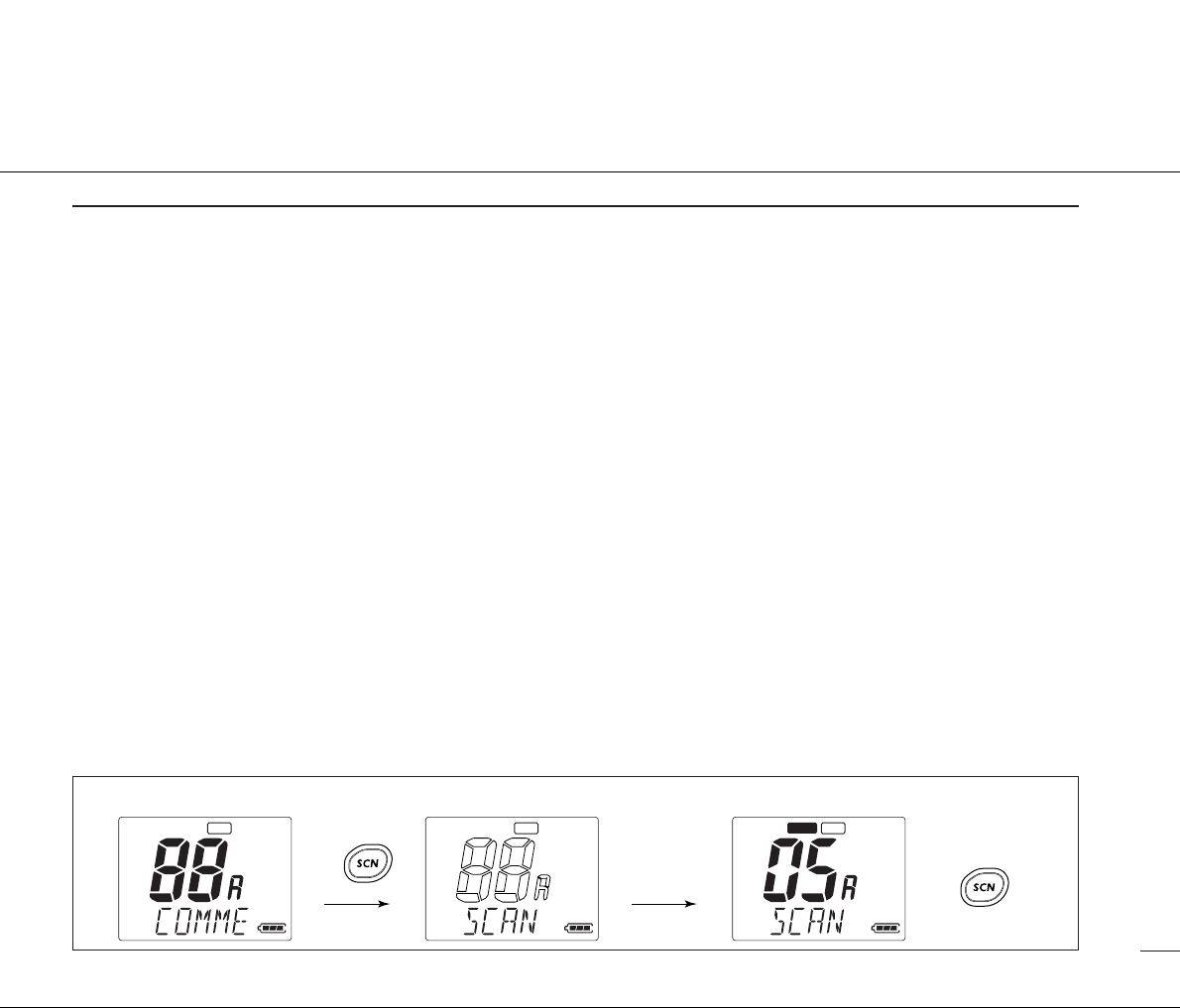
■Setting tag channels
For more efficient scanning, add desired channels as tag
channels or clear tag channels for unwanted channels.
Channels set as non-tag channels will be skipped during
scanning. Tag channels can be assigned to each channel
group (USA, INT, CAN) independently.
qSelect the desired channel group (USA, INT, CAN) by push-
ing [CH/WX•U/I/C] for 2 sec., if desired.
wSelect the desired channel to set as a tag channel.
ePush [SCN•TAG] for 2 sec., to set the displayed channel
as a tag channel.
• “TAG” appears in the function display.
rTo cancel the tag channel setting, push [SCN•TAG] for 2
sec.
• “TAG” disappears.
• Clearing all tag channels in the selected channel group
➥Turn power ON while pushing and holding [SCN•TAG] to
clear all tag channels in the channel group.
■Starting a scan
Set scan type, weather alert function, scan resume timer and
auto scan function in advance using SET mode. (p. 14)
qSelect the desired channel group (USA, CAN, INT) by
pushing [CH/WX•U/I/C] for 2 sec., if desired.
•When the weather alert function is in use, select the desired
weather channel with [CH/WX] and the channel selector.
wPush [SCN] to start priority or normal scan.
• The comment indicator indicates “SCAN”.
• The sub channel readout indicates “16” during priority scan.
•When a signal is received, scan pauses until the signal disap-
pears or resumes after pausing 5 sec. according to SET mode
setting. (Channel 16 is still monitored during priority scan.)
•Push [Y]/[Z] to check the scanning tag channels, to change
the scanning direction or resume the scan manually.
eTo stop the scan, push [SCN].
• “SCAN” disappears.
•Pushing [PTT], [16•9], [CH/WX] or [DW•TRI] also stops the scan.
5
SCAN OPERATION
13
Scan starts. Scan pauses when receiving a
signal and audio is emitted.
Push Push to stop
the scan.
USA
TAG
USA
DUP
TAG
USA
TAG
BUSY
TA G
TA G
[Example]: Starting a normal scan.
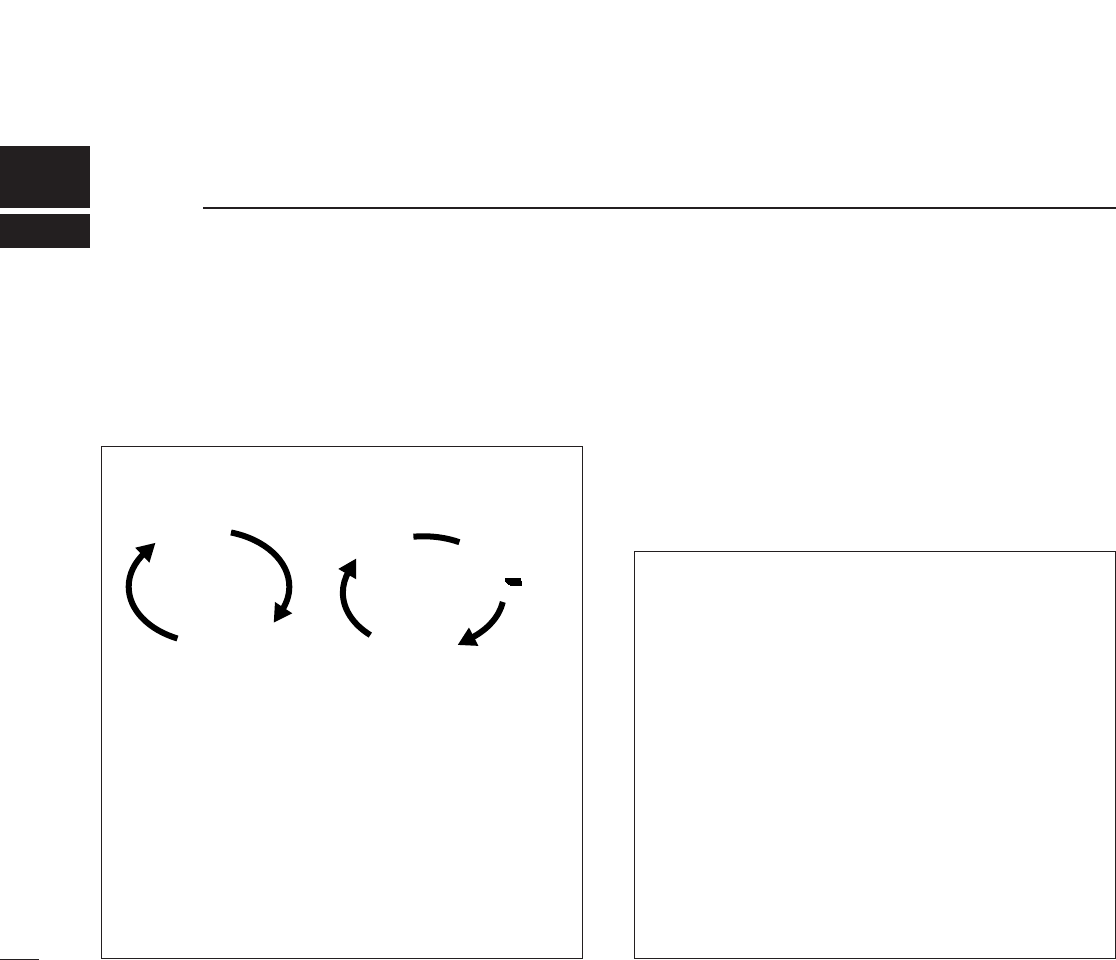
14
6DUAL WATCH/TRI-WATCH
■Description
Dualwatch monitors channel 16 while you are receiving an-
other channel; tri-watch monitors channel 16 and the call
channel while receiving another channel.
■Operation
qSelect the desired operating channel.
wPush [DW•TRI] momentarily to start dualwatch; push
[DW•TRI] for 2 sec. to start tri-watch.
• “DUAL” flashes during dualwatch; “TRI” flashes during tri-watch.
• Beep tone sounds when a signal is received on channel 16.
• Tri-watch becomes dualwatch when receiving a signal on the call
channel.
eTo cancel dualwatch/tri-watch, push [DW•TRI] again.
[Example]: Operating tri-watch on INT channel 07.
DUALWATCH/TRI-WATCH SIMULATION
•If a signal is received on channel 16, dualwatch/tri-watch pauses
on channel 16 until the signal disappears.
•If a signal is received on the call channel during tri-watch, tri-
watch becomes dualwatch until the signal disappears.
•To transmit on the selected channel during dualwatch/tri-watch,
push and hold [PTT].
•If no signal is received, the transceiver enters the power saving
condition for 0.5 sec. after checking the operating channel every
cycle.
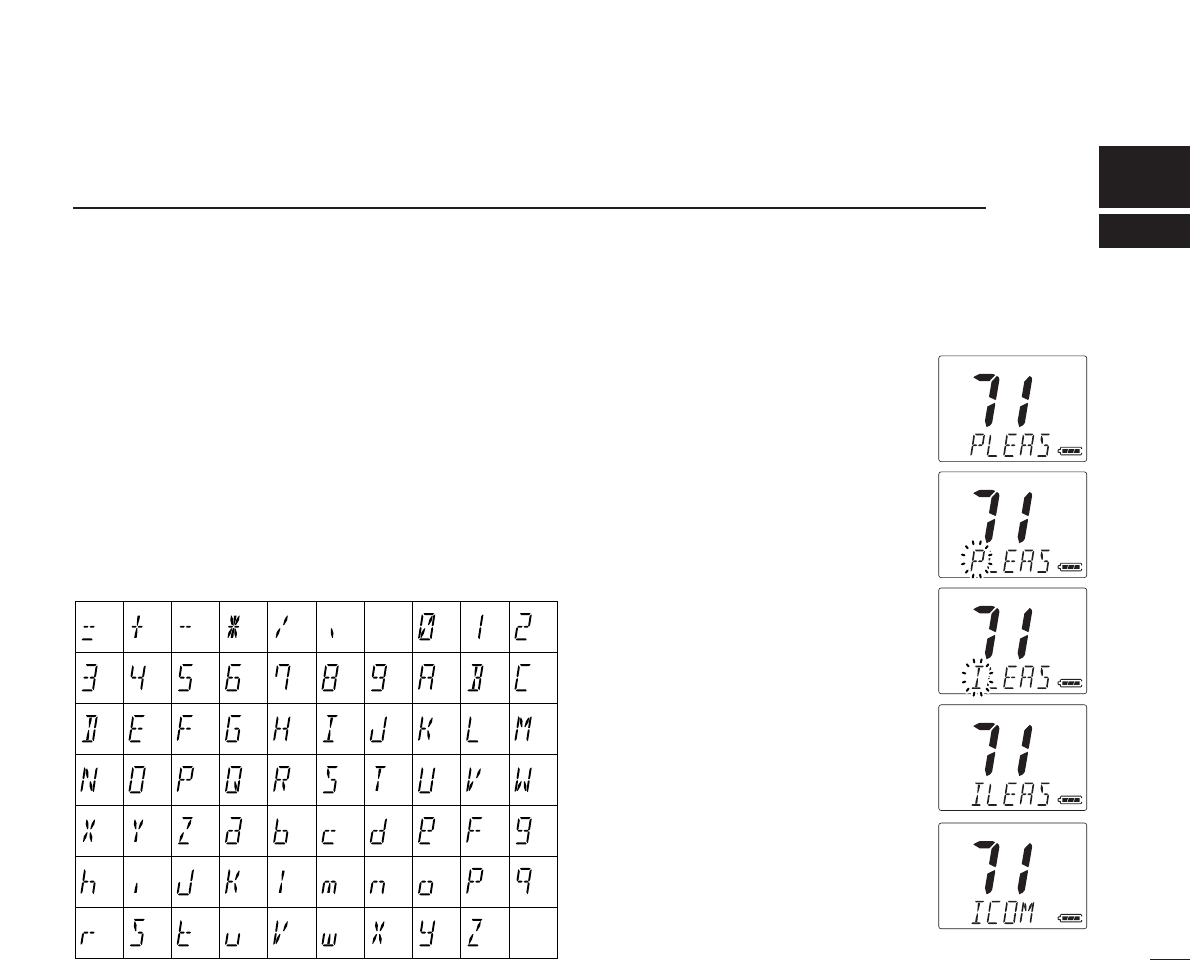
CHANNEL COMMENT PROGRAMMING 7
15
■About the channel comment
The IC-M1V has a capability to assign up to 10-characters
channel comment for each operating channel, includes
weather channel. This provides easy recognition of channel
usage, or station names, etc.
When shipped from the factory, the IC-M1V is programmed
with default comment for each VHF marine channel (refer to
the
CHANNEL LIST
on pgs. ??, ??). These defaults can be
overwritten if desired.
×Available characters
■
Channel comment programming
qPush [Y]/[Z] to select a channel to
program.
• Push [CH/WX•U/I/C] for 2 sec. to select
a channel group, if necessary.
wWhile pushing [MONI], push [DW].
•The 1st character of the currently pro-
grammed comment flashes.
ePush [Y]/[Z] to select a character.
rPush [SCN] to move to the right;
then push [Y]/[Z] to select a charac-
ter.
• Pushing [H/L], moves to left
tContinue until the desired characters
have been selected, then push [DW]
to return to normal operation.
(=)
(3)
(D)
(N)
(X)
(h)
(r)
(+)
(4)
(E)
(O)
(Y)
(i)
(s)
(–)
(5)
(F)
(P)
(Z)
(j)
(t)
(=)
(6)
(G)
(Q)
(a)
(k)
(u)
(/)
(7)
(H)
(R)
(b)
(l)
(v)
(,)
(8)
(I)
(S)
(c)
(m)
(w)
(space)
(9)
(J)
(T)
(d)
(n)
(x)
(0)
(A)
(K)
(U)
(e)
(o)
(y)
(1)
(B)
(L)
(V)
(f)
(p)
(z)
(2)
(C)
(M)
(W)
(g)
(q)
INT
INT
INT
INT
INT
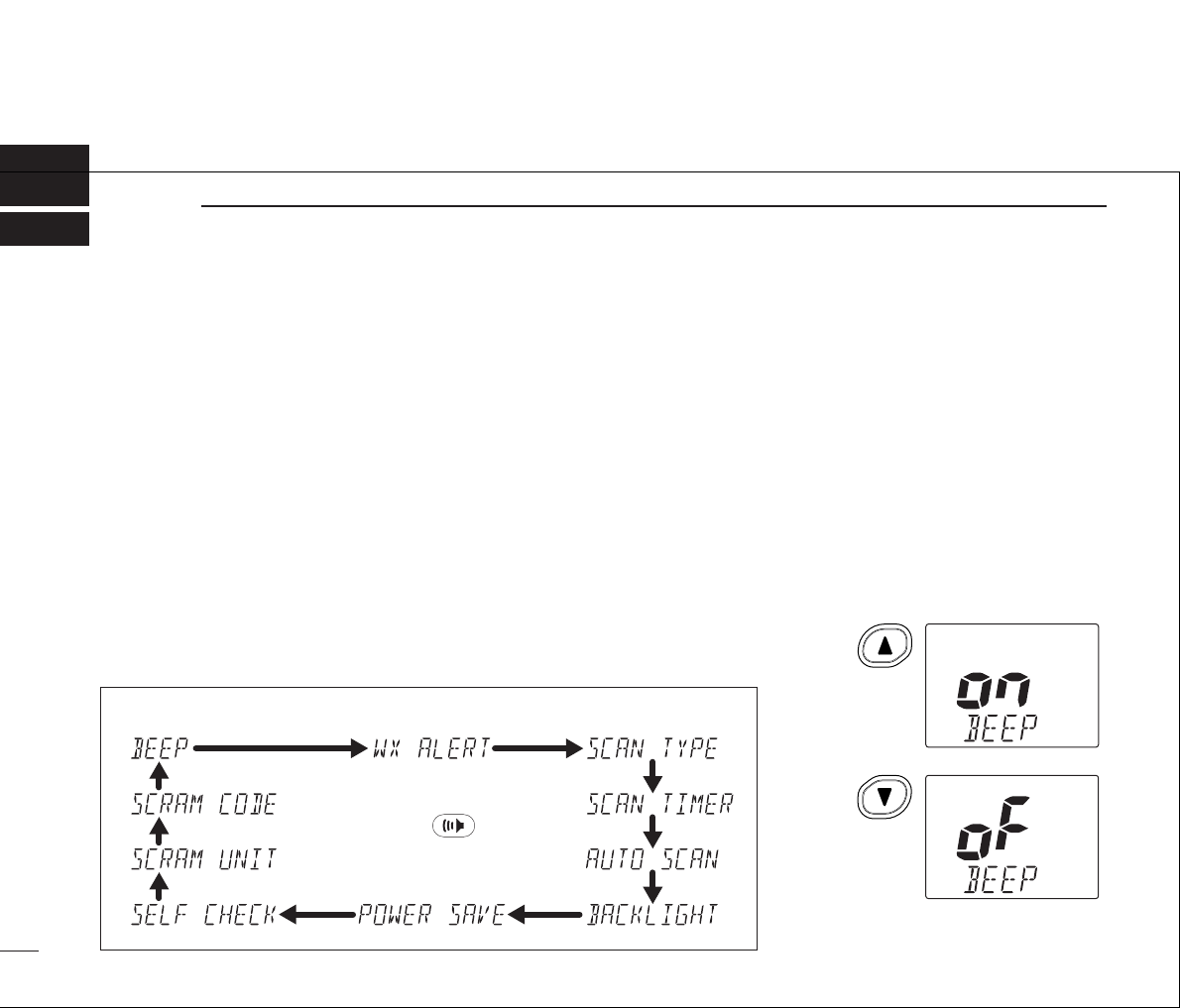
SET mode is used to change the condi-
tions of 10 transceiver functions: beep
tone function, weather alert function,
scan type (normal/priority), scan resume
timer, auto scan function, auto watch,
automatic backlighting, power saver
function, self check function, voice
scrambler type and scrambling code.
When no optional voice scrambler unit
is installed, voice scrambler type and
scrambling code setting are not
qTurn power OFF.
wWhile pushing [MONI], turn power
ON and continue pushing [MONI]
until emits beep.
•
After beep emission, release [MONI].
• Set mode item at comment indicator and
condition at channel number readout are
displayed.
rPush [MONI] to select the desired
item, if necessary.
tPush [Y]/[Z] to select the desired
condition of the item.
yTo exit SET mode, push [16].
• Turning power OFF, then ON again also
exits SET mode.
■SET mode items
×Beep tone “BEEP”
You can select silent operation by turn-
ing beep tones OFF or you can have
confirmation beeps sound at the push
of a switch by turning beep tones ON.
The beep tone volume is linked with
[VOL].
8SET MODE
16
Automatic backlighting
Weather alert
Power save
Scan resume
timer
Scan type
Beep tone
Scrambler
unit selection
Scrambling
code
Self check function
Auto scan
Push
• SET mode construction
Push
Beep ON
(default)
Beep OFF
Push
■SET mode programming
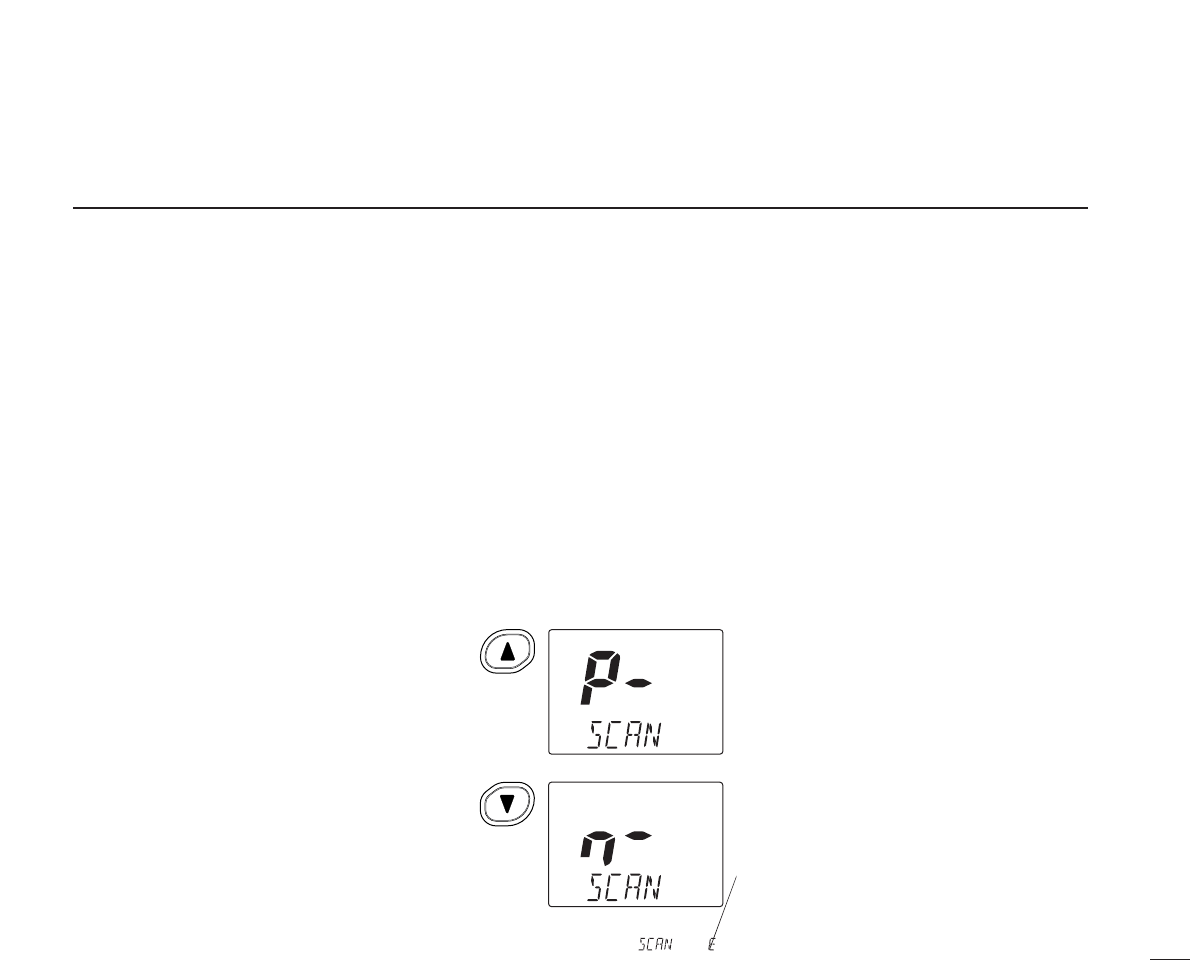
8
SET MODE
17
×Weather alert function
“WX ALERT”
An NOAA broadcast station transmits
an weather alert tone before an impor-
tant weather information. When the
weather alert function is turned ON, the
transceiver detects the alert, then
flashes the “ALT” indicator until the
transceiver is operated. The previously
selected (used) weather channel is
checked in any time during standby or
while scanning.
• “ALT” appears when the function is set ON.
×Scan type selection
“SCAN TYPE”
The transceiver has 2 scan types: nor-
mal scan and priority scan. Normal
scan searches all tag channels in the
selected channel group. Priority scan
searches all tag channels in sequence
while monitoring channel 16.
×Scan resume timer
“SCAN TIMER”
The scan resume timer can be selected
as a pause (OFF) or timer scan (ON).
When OFF is selected, the scan
pauses until the signal disappears.
When ON is selected, the scan pauses
5 sec. and resumes even if a signal is
being received on channels except for
channel 16.
Push
Normal scan
selection
(default)
Priority scan
selection
Push
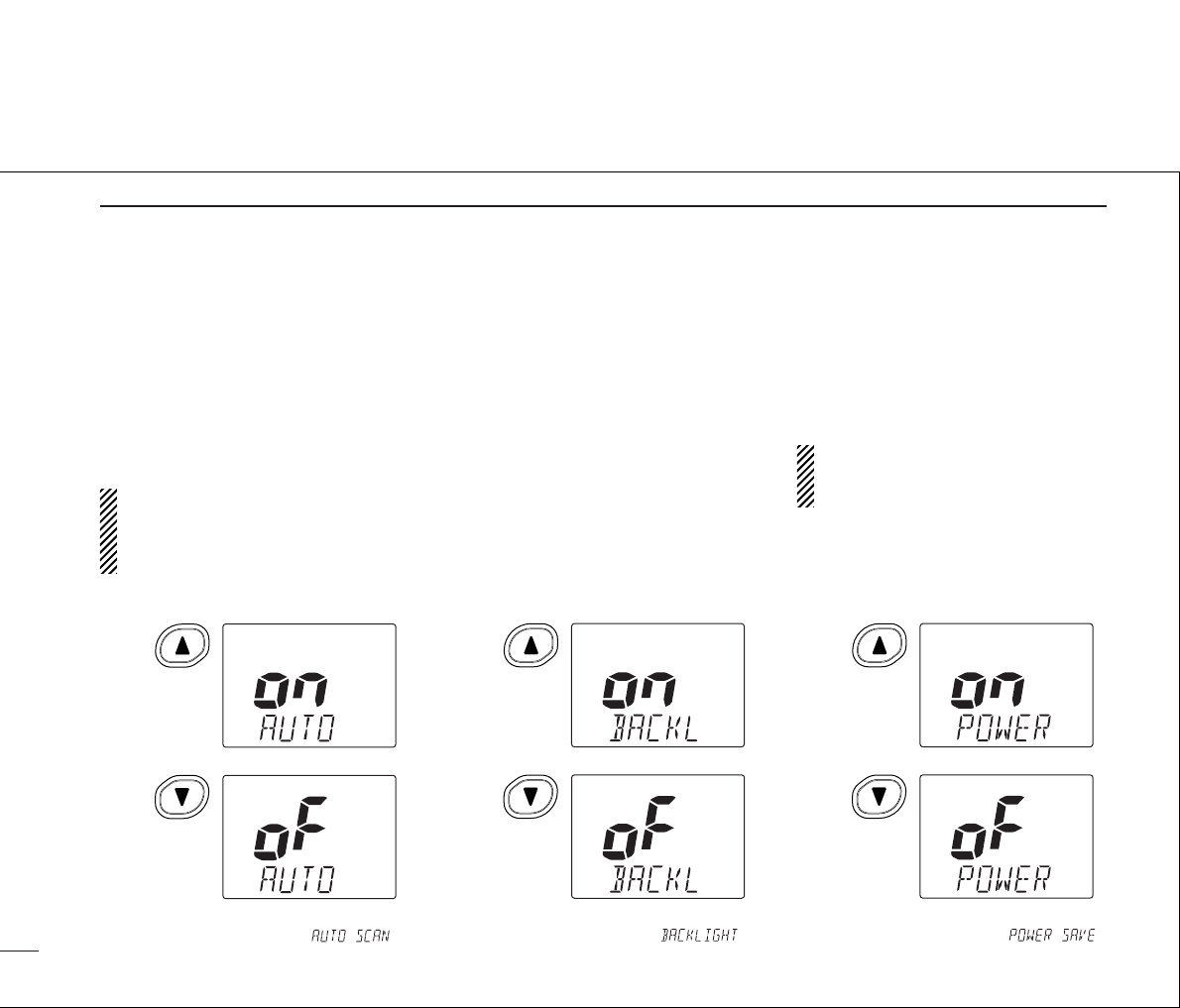
18
8SET MODE
×Auto scan function
“AUTO SCAN”
While in standby, this function automat-
ically starts the desired scan (normal or
priority scan) 30 sec. after operation.
•“SCAN” appears when the function is
turned ON.
The transceiver has a power save
function but the power save function
does not function when the auto
scan function is in use.
×Automatic backlighting
“BACKLIGHT”
This function is convenient for nighttime
operation. The automatic backlighting
turns the backlighting ON when pushing
any key except for [PTT].
•The backlighting automatically turns OFF
5 sec. after operation.
•Push [MONI] to turn the backlighting ON
without changing the operating condition.
• The backlighting ON when entering SET
mode, regardless of this setting.
×Power save function
“POWER SAVE”
The power saver function reduces cur-
rent drain by deactivating the receiver
circuit for present intervals.
The power save function does not
function when the auto scan function
is in use.
Push
Power save
ON (default)
Power save
OFF
Push
Scrolls the channel
comment, “ ”.
Push
Automaric
backlighting
ON (default)
Automaric
backlighting
OFF
Push
Scrolls the channel
comment, “ ”.
Push
Auto scan
ON
Auto scan
OFF (default)
Push
Scrolls the channel
comment, “ ”.
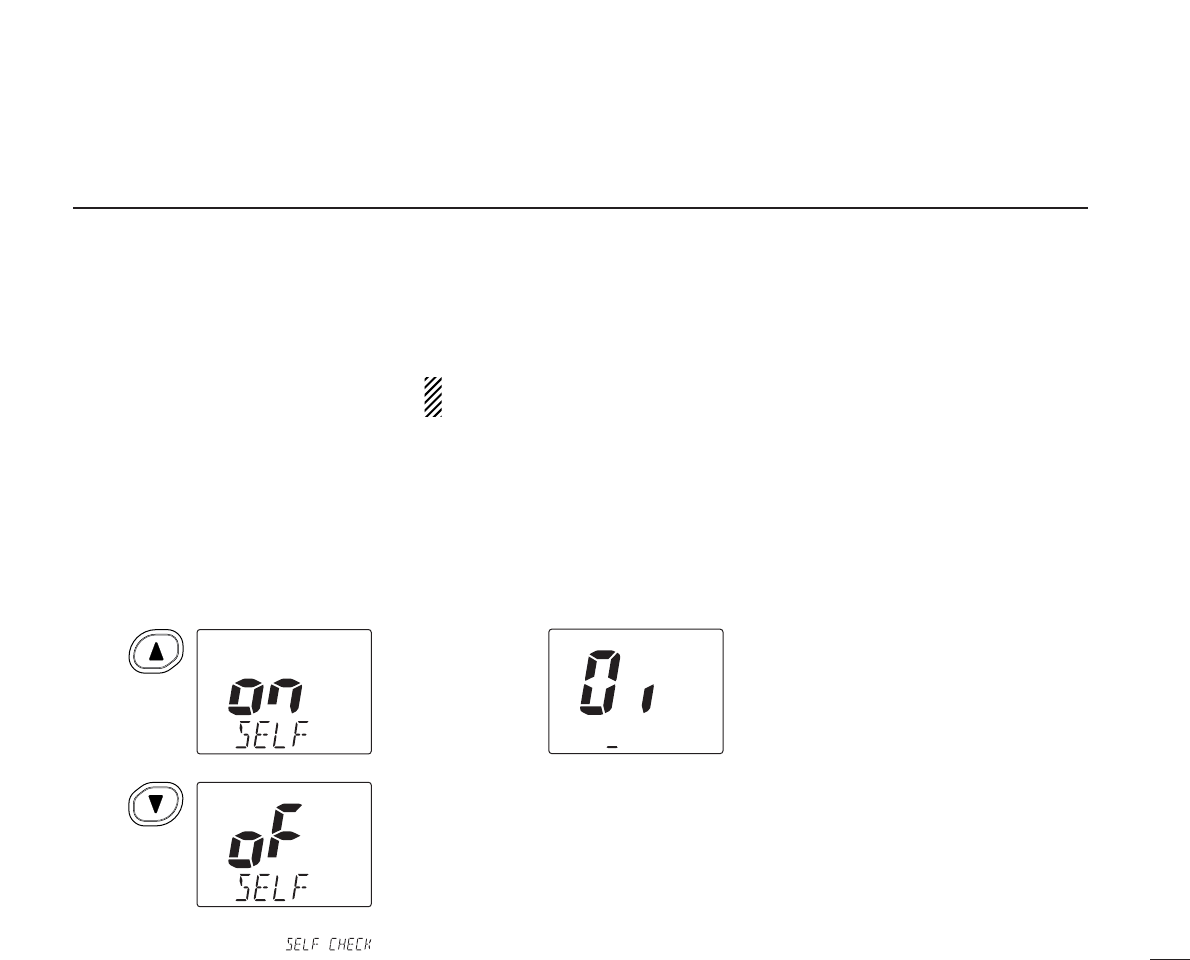
19
8
SET MODE
×Self check function
“SELF CHECK”
The self check function checks trans-
ceiver conditions by itself and informs
you in case of problem is found. Follow-
ing contents are checked after power
ON, then turning into operation mode
when no problem is found.
• PLL lock (both transmit and receive)
• Temperature
• Connected battery voltage
• Water intrusion
×Scrambler unit selection
“SCRAM UNIT”
This item appears only when voice
scrambler unit is installed.
Selects installed voice scrambler unit,
otherwise the voice scrambler function
not performed properly.
×Scrambler code
“SCRAM CODE”
There are 128 codes (00 to 127) avail-
able with UT-98 or 32 codes (00 to 31)
available with UT-122 for programming.
In order to understand one another, all
transceivers in your group must have
the same unit* and scramble code.
*Different scrambling system is used be-
tween UT-98 and UT-122, therefore, the
same unit must be used in your group .
Push
Self check
function ON
Self check
function OFF
(default)
Push
Scrolls the channel
comment, “ ”.

9BATTERY CHARGING
20
■Battery cautions
NEVER incinerate used battery packs. Internal battery gas
may cause an explosion.
NEVER immerse the battery pack in water. If the battery pack
becomes wet, be sure to wipe it dry BEFORE attaching it to
the transceiver.
NEVER short terminals of the battery pack. Also, current may
flow into nearby metal objects so be careful when placing bat-
tery packs in handbags, etc.
AVOID leave the battery pack with fully charged or completely
discharged condition for long time. It makes shorter battery
life. In case of leaving the battery pack for long time, must be
in safekeeping after discharge or use the battery until the bat-
tery indicator shows middle level, then release from the trans-
ceiver.
If your battery pack seems to have no capacity even after
being charged, completely discharge it by leaving the power
ON overnight. Then, fully charge the battery pack again. If the
battery pack still does not retain a charge (or very little), a
new battery pack must be purchased.
■Battery charging
Prior to using the transceiver for the first time, the battery
pack must be fully charged for optimum life and operation.
CAUTION: To avoid damage to the transceiver, turn it OFF
while charging.
• Recommended temperature range for charging:
+10°C to +40°C (+50°F to +104°F)
•Use the supplied charger (AD-95) only. NEVER use other
manufactures’ charger.
•An optional cable OPC-515L (for 13.8 V power source) or
CP-17L (for 12 V cigarette lighter socket) can be used in-
stead of the AC adapters of above chargers.
CAUTION: DO NOT leave the battery pack in the charger
more than 1 hour after the charging indicator lights OFF. It
will make shorter battery life, due to over charging.

×Attaching the AD-95 to a desktop
×Attaching the AD-95 to a wall
×Charging
qConnect the AC adapter (BC-122) or optional cable (CP-
17L or OPC-515L) as shown below.
wInsert the battery pack only or with the transceiver into the
charger.
• The charge indicator lights green.
eCharge the battery pack for approx. 8 hours.
9
BATTERY CHARGER
21
Eyelet:
USE a rubber
band to secure
the transceiver,
if desired.
AVOID overcharging!
The AD-95 is NOT a
transceiver hanger. Take
out the battery within
1 hour after charged.

22
10 SPEAKER-MICROPHONE
■Speaker-microphone
descriptions
IMPORTANT: KEEP the [SP MIC] jack cover attached
(transceiver) when speaker-microphone is not in use.
Water will not coming into the transceiver even the cover is
not attached, however, the terminals (pins) become rusty
when the connector has wet.
NEVER immerse the connector in water. If the connector be-
comes wet, be sure to dry BEFORE attaching it to the trans-
ceiver.
■Attachment
Insert the connector of the speaker-microphone into the
[SP MIC] connector on the transceiver and rotates (screws)
the connector cover as shown in the diagram below.
NOTE: The microphone element is located at the top of
the speaker-microphone. To maximize the readability of
your transmitted signal (voice), hold the microphone ap-
prox. 2.5 cm (1 inch) from your mouth, and speak at a nor-
mal voice level.
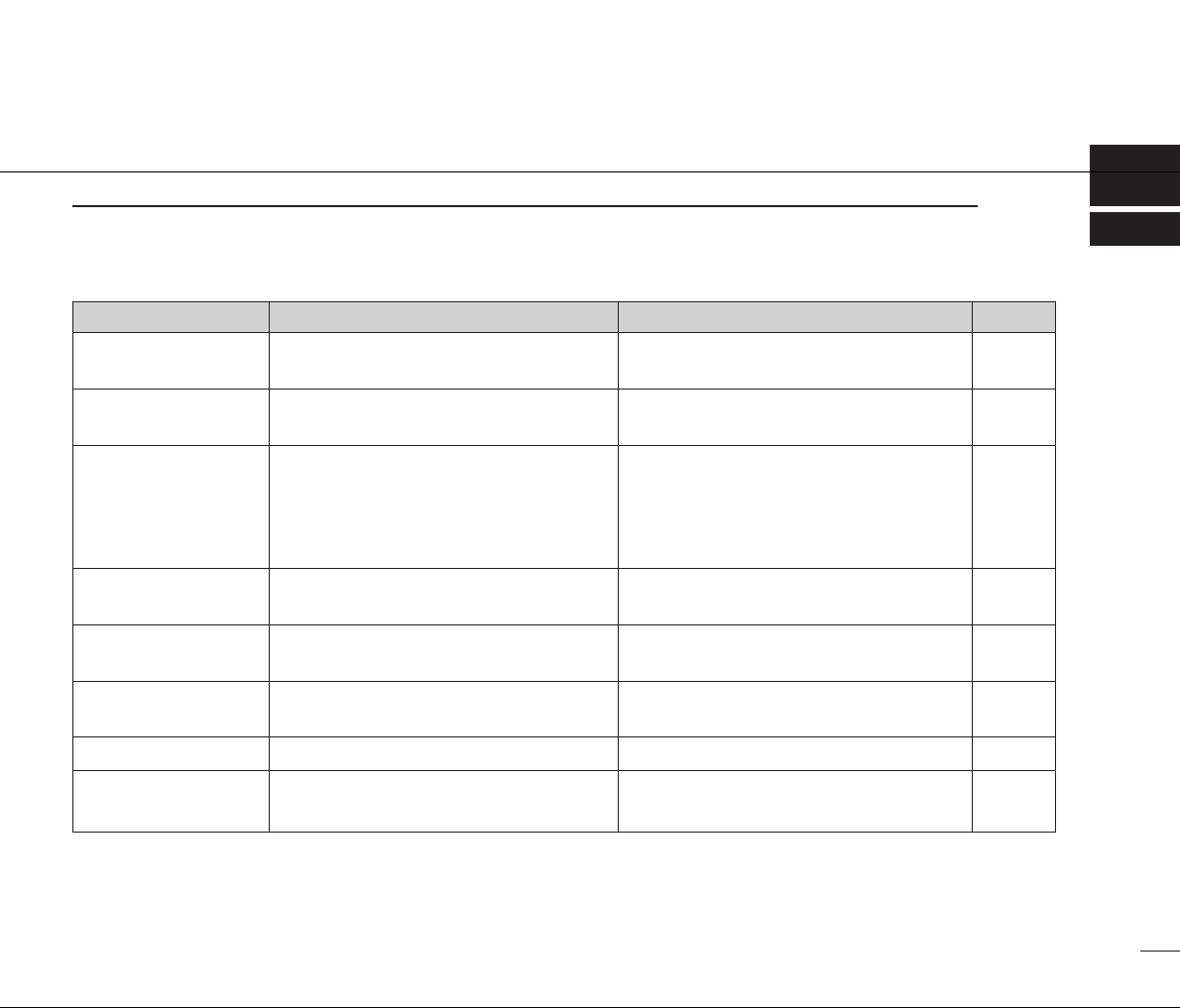
11
TROUBLESHOOTING
23
POSSIBLE CAUSE
• The battery is exhausted.
• Bad connection to the battery pack.
• Squelch level is too deep.
• [OFF/VOL] level is too low.
•Some channels are for low power or
receive only.
• The battery is exhausted.
•The output power is set to low or extra
low.
• Lock function is activated.
• “TAG” channel is not programmed.
• Auto scan function is activated.
• Beep tone is turned OFF.
• Optional voice scrambler is turned OFF.
• Scramble code is not set correctly.
PROBLEM
No power comes ON.
No sound comes from
the speaker
Transmitting is impossi-
ble, or high power can-
not be selected.
The displayed channel
cannot be changed.
Scan does not start.
Scan starts automati-
cally.
No beep sounds.
Receive signal cannot
be understood.
SOLUTION
• Recharge the battery pack.
• Check the connection to the transceiver.
• Set squelch to the threshold point.
• Set [OFF/VOL] to a suitable level.
• Change channels.
• Recharge the battery pack.
• Push [H/L] to select high power.
•Push [H/L•LOCK] for 2 sec. to cancel the
function.
•Set the desired channels as “TAG” chan-
nels.
•Cancel the auto scan function in SET
mode.
• Turn the beep tone ON in SET mode.
• Turn the optional voice scrambler ON.
• Reset the scramble code.
REF.
p. 15
p. 2
p. 6
p. 7
pgs.
5, 7
p. 15
p. 7
p. 6
p. 12
p. 14
p. 13
p. 8
p. 8
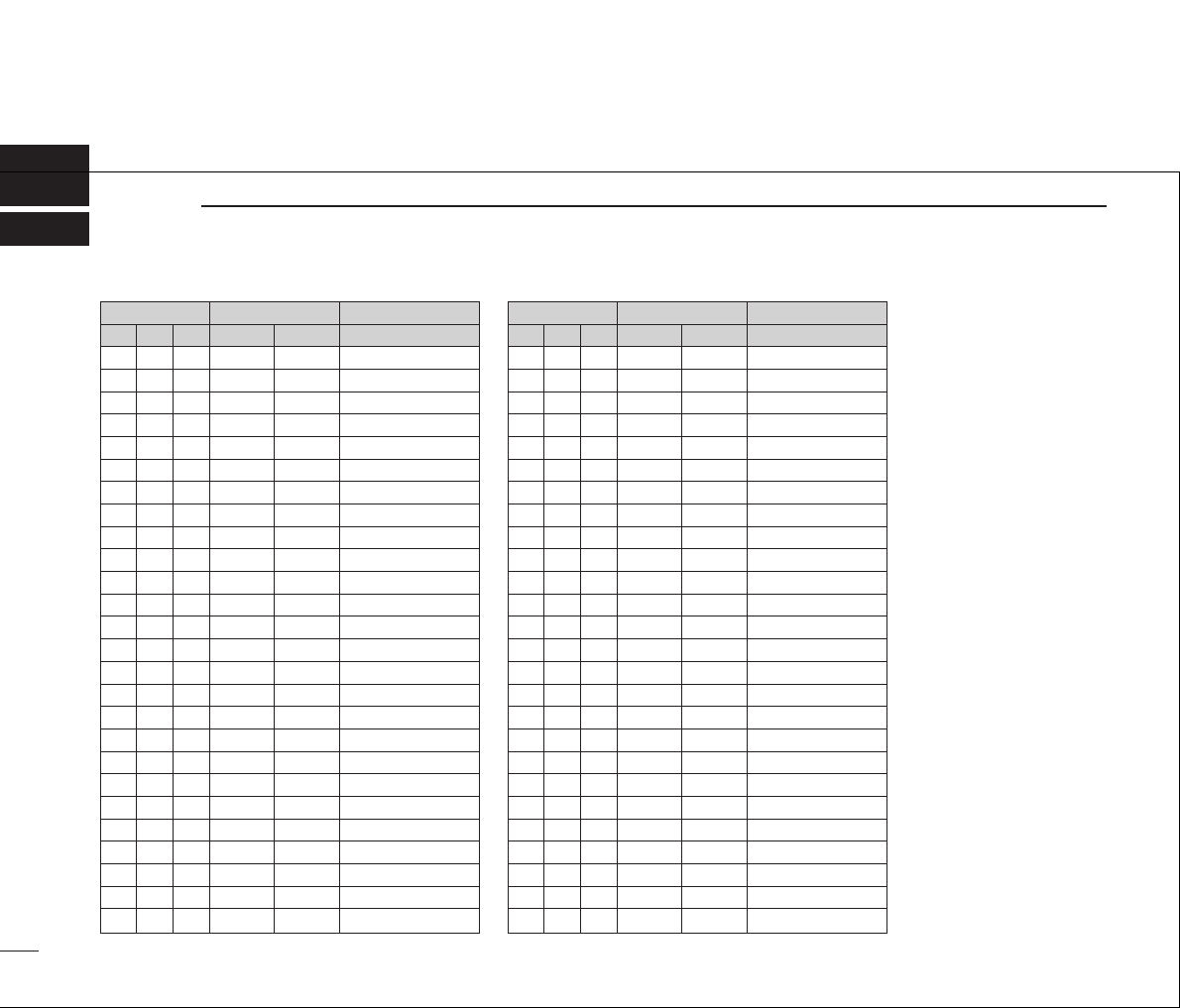
Channel Number
Frequency (MHz) Channel comment
USA
INT CAN Transmit Receive
01 01 156.050 160.650 TELEPHONE
01A 156.050 156.050 VTS
02 02 156.100 160.700 TELEPHONE
02A 156.100 156.100
03 03 156.150 160.750 TELEPHONE
03A 156.150 156.150
04 156.200 160.800 INTL
04A 04A 156.200 156.200 CCG
05 156.250 160.850 INTL
05A 05A 156.250 156.250 VTS
06 06 06 156.300 156.300 SAFETY
07 156.350 160.950 INTL
07A 07A 156.350 156.350 COMMERCIAL
08 08 08 156.400 156.400 COMMERCIAL
09 09 09 156.450 156.450 CALLING
10 10 10 156.500 156.500 COMMERCIAL
11 11 11 156.550 156.550 VTS
12 12 12 156.600 156.600 VTS
13*113 13*1156.650 156.650 BRG/BRG
14 14 14 156.700 156.700 VTS
15*115*115*1156.750 156.750 COMMERCIAL
16 16 16 156.800 156.800 CALLING
17*117 17*1156.850 156.850 SAR
18 156.900 161.500 INTL
18A 18A 156.900 156.900 COMMERCIAL
19 156.950 161.550 INTL
24
12 CHANNEL LIST
*1Low power only. *2Receive only.
Channel Number
Frequency (MHz) Channel comment
USA INT CAN Transmit Receive
19A 19A 156.950 156.950 COMMERCIAL
20 20 20*1157.000 161.600 PORT OPR
20A 157.000 157.000 PORT OPR
21 21 157.050 161.650 INTL
21A 21A 157.050 157.050 CCG
21b 157.050 157.050 CMBS
22 157.100 161.700 INTL
22A 22A 157.100 157.100 USCG
23 23 157.150 161.750 INTL
23A 157.150 157.150 USCG
24 24 24 157.200 161.800 TELEPHONE
25 25 25 157.250 161.850 TELEPHONE
25b 157.250 161.850 CMBS
26 26 26 157.300 161.900 TELEPHONE
27 27 27 157.350 161.950 TELEPHONE
28 28 28 157.400 162.000 TELEPHONE
28b 157.400 162.000 CMBS
60 60 156.025 160.625 TELEPHONE
60A 156.025 156.025
61 156.075 160.675 INTL
61A 61A 156.075 156.075 CCG
62 156.125 160.725 INTL
62A 62A 156.125 156.125 CCG
63 156.175 160.775 INTL
63A 156.175 156.175 VTS
64 64 156.225 160.825 TELEPHONE
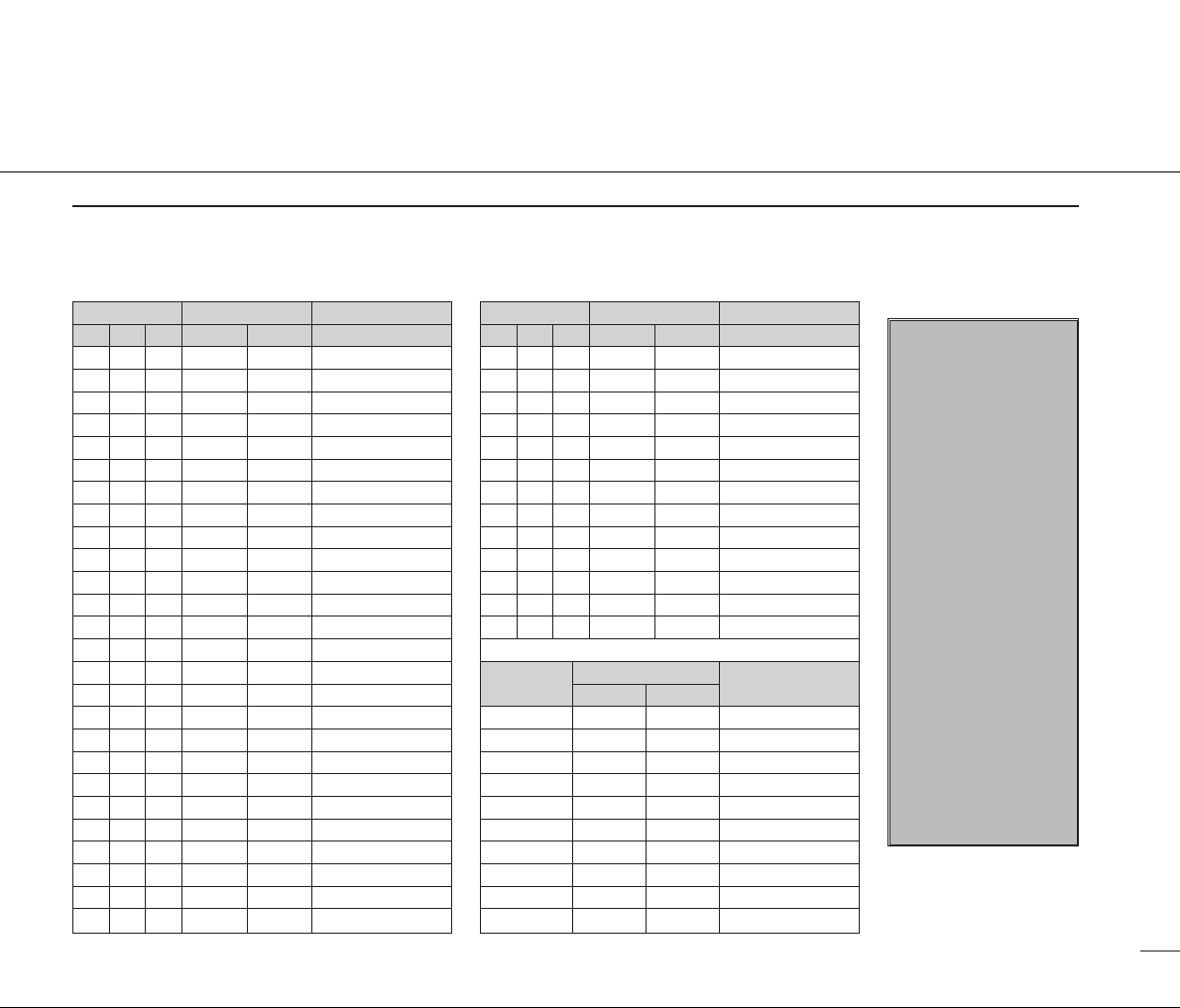
25
12
CHANNEL LIST
Channel Number
Frequency (MHz) Channel comment
USA INT CAN Transmit Receive
83 83 157.175 161.775 CCG
83A 83A 157.175 157.175 CCG
83b 157.175 157.175 CMBS
84 84 84 157.225 161.825 TELEPHONE
84A 157.225 157.225
85 85 85 157.275 161.875 TELEPHONE
85A 157.275 157.275
86 86 86 157.325 161.925 TELEPHONE
86A 157.325 157.325
87 87 87 157.375 161.975 TELEPHONE
87A 157.375 157.375
88 88 88 157.425 162.025 TELEPHONE
88A 157.425 157.425 COMMERCIAL
WX channel Frequency (MHz) Channel comment
Transmit Receive
WX01 Rx only 162.550
WX02 Rx only 162.400
WX03 Rx only 162.475
WX04 Rx only 162.425
WX05 Rx only 162.450
WX06 Rx only 162.500
WX07 Rx only 162.525
WX08 Rx only 161.650
WX09 Rx only 161.775
WX10 Rx only 163.275
*1Low power only. *2Receive only.
64A 64A 156.225 156.225 COMMERCIAL
Channel Number
Frequency (MHz) Channel comment
USA INT CAN Transmit Receive
65 156.275 160.875 INTL
65A 65A 65A 156.275 156.275 PORT OPR
66 156.325 160.925 INTL
66A 66A
66A*1
156.325 156.325 PORT OPR
67*167 67 156.375 156.375 BRG/BRG
68 68 68 156.425 156.425 SHIP–SHIP
69 69 69 156.475 156.475 PLEASURE
70*270*270*2156.525 156.525 DSC
71 71 71 156.575 156.575 PLEASURE
72 72 72 156.625 156.625 SHIP–SHIP
73 73 73 156.675 156.675 PORT OPR
74 74 74 156.725 156.725 PORT OPR
75 75 75 Guard Guard
76 76 76 Guard Guard
77*177 77*1156.875 156.875 PORT OPR
78 156.925 161.525 INTL
78A 78A 156.925 156.925 SHIP–SHIP
79 156.975 161.575 INTL
79A 79A 156.975 156.975 SHIP–SHIP
80 157.025 161.625 INTL
80A 80A 157.025 157.025 SHIP–SHIP
81 157.075 161.675 INTL
81A 81A 157.075 157.075 CCG
82 157.125 161.725 INTL
82A 82A 157.125 157.125 CCG
TELEPHONE :
public correspondence
PLEASURE :
pleasure boat use
SAFETY :
safety communications
PORT OPR :
port operations
VTS :
vessel traffic control
SHIP–SHIP :
intership communications
CMBS :
continuous marine broad-
cast system
COMMERCIAL :
commercial use
USCG :
United States Coast Guard
BRG/BRG :
bridge to bridge communi-
cations
INTL :
outside of the US or
Canada
SAR :
search and rescue
CCG :
Canadian Coast Guard
CHANNEL NAME KEY

26
13 SPECIFICATIONS AND OPTIONS
■Specifications
• GENERAL
• Frequency coverage : Transmit 156–157.5 MHz
Receive 156–163 MHz
• Mode : FM (16K0G3E)
• Channel spacing : 25 kHz
• Current drain (at 7.4 V) : TX 5 W 1.5 A max.
Max.audio 200 mA max.
Power saved ?? mA typ.
• Power supply requirement : Icom battery pack, BP-215
• Frequency stability :
±10 ppm
(–20°C to +60°C; –4°F to +140°F)
• Dimensions (with BP-215) : 52.5(W) ×129(H) ×30(D) mm
(Projection not included) 21⁄16(W) ×53⁄32(H) ×13⁄16(D) in
• Weight (with BP-215) : 280g (9.9 oz)
• TRANSMITTER
• Output power : 5 W, 1 W and 0.5 W
• Modulation system :
Variable reactance frequency modulation
• Max. frequency deviation : ±5.0 kHz
• Spurious emissions : Less than –65 dB
• RECEIVER
• Receive system :
Double conversion superheterodyne
• Sensitivity (12 dB SINAD) : Less than 0.35 µV
• Squelch sensitivity : Adjustable up to 23 dB SINAD
•
Intermodulation rejection ratio
: 70 dB typical
•
Spurious response rejection ratio
: 70 dB typical
• Adjacent channel selectivity : 70 dB typical
• Audio output power : 350 mW typical at 10% distortion
with an 8 Ωload
■Options
• AD-95 BATTERY CHARGER + BC-122A/E AC ADAPTER
Used for regular charging of battery pack. The same as supplied with
the transceiver. Charging time: 8 hours
• BP-215 BATTERY PACK
Long life, Li-ion battery pack allowing 12–14 hrs.* operation. The
same as supplied with the transceiver. 7.4 V/1600 mAh.
*Tx:Rx:Stand-by=5:5:90
• CP-17L CIGARETTE LIGHTER CABLE
Connects to a ship’s or vehicle’s cigarette lighter socket (12 V) for use
with the AD-95.
• FA-S57V FLEXIBLE ANTENNA
Same as supplied with the transceiver.
• HM-125 SPEAKER-MICROPHONE
Full-sized waterproof (JIS grade 7; 1m/30 min.) speaker-microphone
including alligator type clip to attach to your shirt or collar, etc.
• OPC-515L DC POWER CABLE
Used for charging a battery pack via an AD-95 with external power
supply.
• UT-98 VOICE SCRAMBLER UNIT
Ensures private communications. 128 scrambling codes are avail-
able. The scrambling system is not compatible with UT-122. Not
available in some countries.
• UT-122 VOICE SCRAMBLER UNIT
Ensures private communications. 32 scrambling codes are available.
The scrambling system is not compatible with UT-98. Not available
in some countries.
All stated specifications are subject to change without notice or obligations.
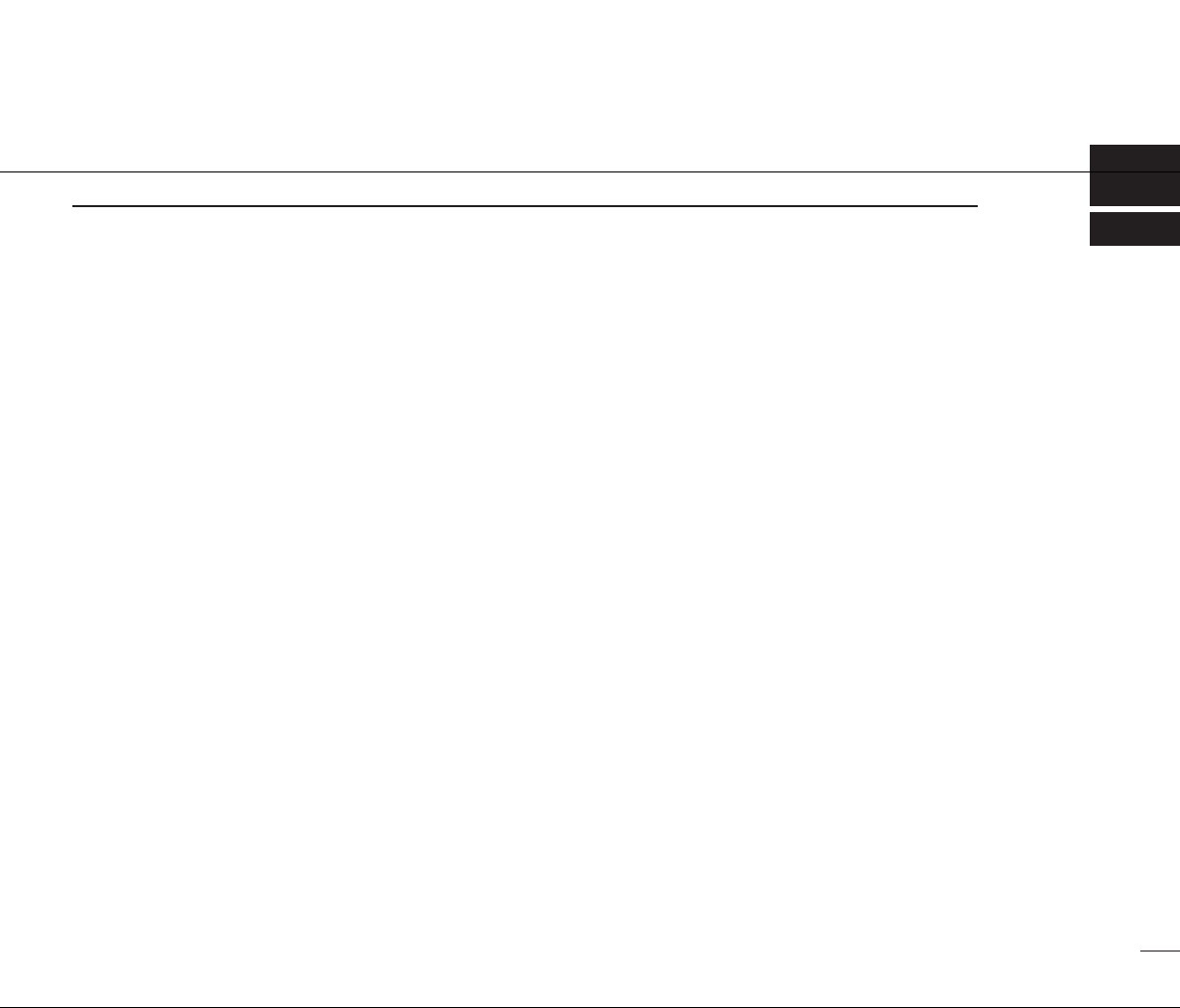
27
14
INDEX
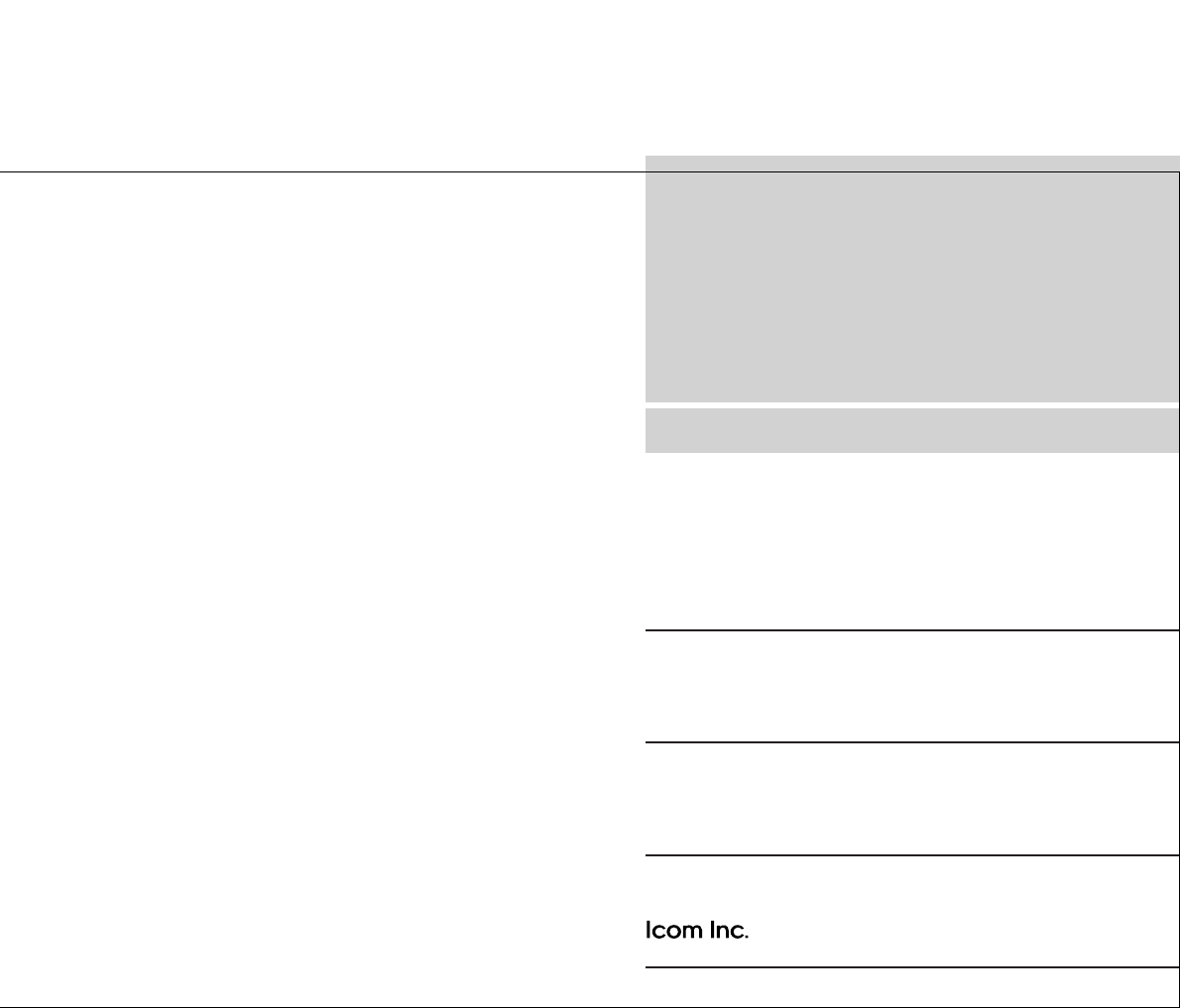
Count on us!
6-9-16 Kamihigashi, Hirano-ku, Osaka 547-0002 Japan
A-5373H-1US
Printed in Japan
© 1999 Icom Inc.